Bachelor & master theses in the research field of human-computer interaction
We offer thesis topics for bachelor and master level of the study programmes media informatics, computer science, software engineering, and cognitive systems.
Below you can find an uptodate list of topic suggestions. Of cource, we are open to discuss any proposals by students in our research field. The descriptions are partially only visible inside the campus net.
If you are interested, please directly get in touch with a research associate of the research group .
For further questions about howto conceptualise and write a thesis, please take a look at the FAQ section .

Overview of currently available thesis topics (bachelor level)
| Supervisor: | |
| Supervisor: | |
| Supervisor: | |
| Supervisor: | |
| Supervisor: | |
| Supervisor: | |
| Supervisor: | |
| Supervisor: | |
| Supervisor: | |
| Supervisor: | |
| Supervisor: | |
| Supervisor: | |
| Supervisor: | |
| Supervisor: | |
| Supervisor: and | |
| Supervisor: | |
| Supervisor: | |
| Supervisor: | |
| Supervisor: | |
| Supervisor: | |
| Supervisor: | |
| Supervisor: | |
| Supervisor: |
Overview of currently available thesis topics (master level)
| Supervisor: | |
| Supervisor: | |
| Supervisor: | |
| Supervisor: | |
| Supervisor: | |
| Supervisor: | |
| Supervisor: | |
| Supervisor: | |
| Supervisor: and | |
| Supervisor: | |
| Supervisor: | |
| Supervisor: | |
| Supervisor: | |
| Supervisor: | |
| Supervisor: | |
| Supervisor: | |
| Supervisor: | |
| Supervisor: | |
| Supervisor: | |
| Supervisor: | |
| Supervisor: | |
| Supervisor: | |
| Supervisor: | |
| Supervisor: |
Details about individual topics
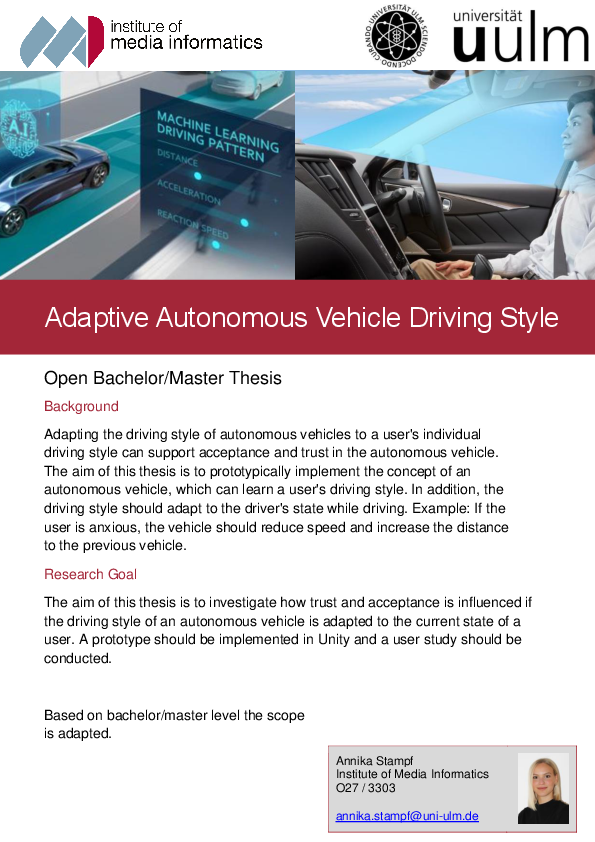
Adaptive Autonomous Vehicle Driving Style
Supervisor: Annika Stampf
Level: Bachelor / Master
Description:
The aim of this thesis is to investigate how trust and acceptance is influenced if the driving style of an autonomous vehicle is adapted to the current state of a user. A prototype should be implemented in Unity and a user study should be conducted.
Anthropomorphism in Highly Automated Vehicles
The aim of this work is to investigate what anthropomorphic features can be used in in-vehicle interfaces (such as physiological signals, e.g. heart beat or a nudge to the driver from the vehicle). These identified features should be implemented prototypically in a VR environment with Unity. Subsequently, a user study should be conducted to evaluate whether those identified features have a positive impact on passengers' trust in HAVs.
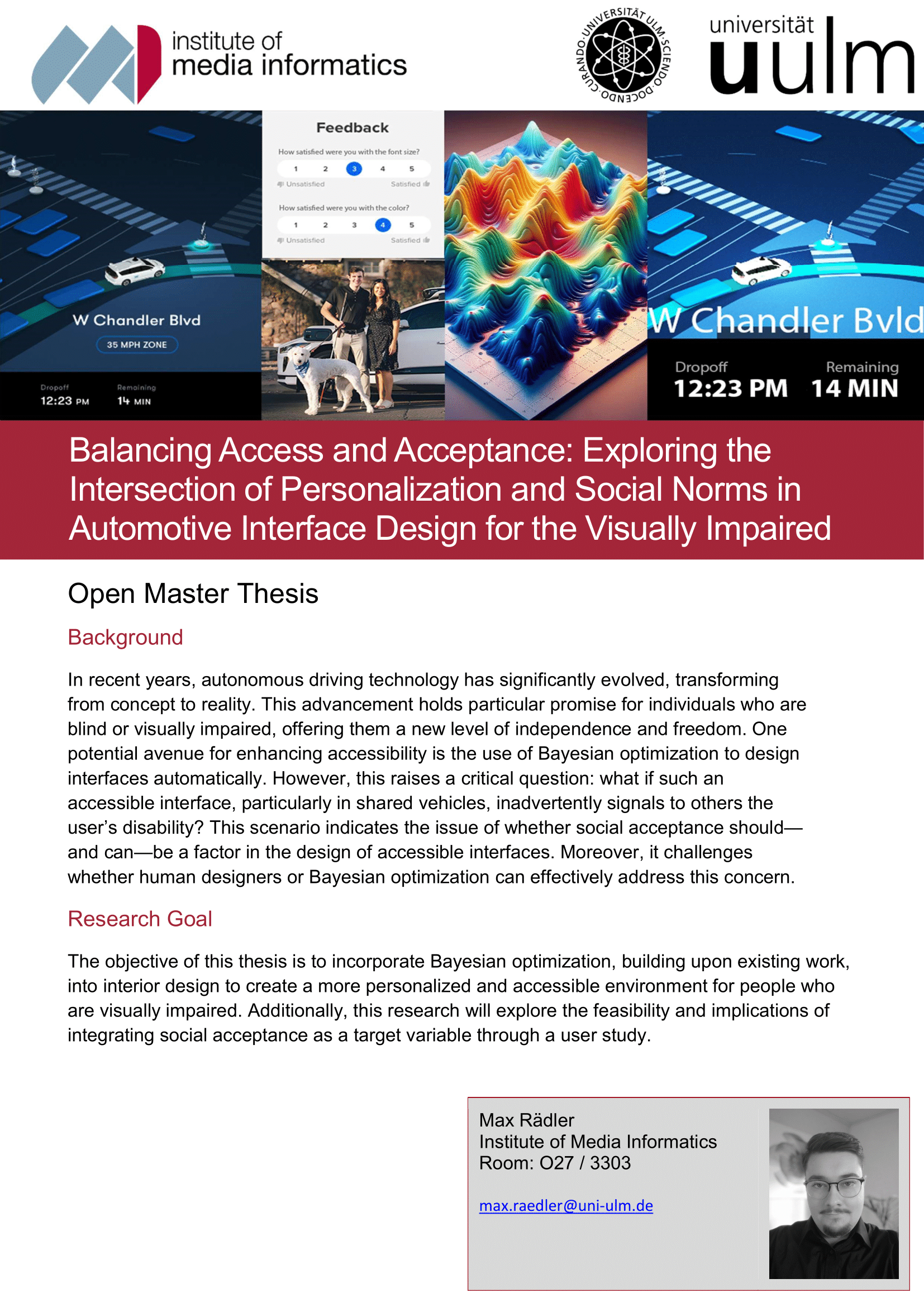
Balancing Access and Acceptance: Exploring the Intersection of Personalization and Social Norms in Automotive Interface Design for the Visually Impaired
Supervisor: Max Rädler
Level: Master
This thesis explores the use of Bayesian optimization to design accessible interfaces for autonomous vehicles, focusing on the visually impaired. As autonomous driving evolves, offering new levels of independence, the challenge arises in designing interfaces that do not inadvertently disclose the user's disability in shared settings. This research aims to incorporate Bayesian optimization into vehicle interior design, creating personalized environments while considering social acceptance as a crucial factor. The feasibility of these designs will be assessed through a user study, exploring the balance between accessibility and social discretion.
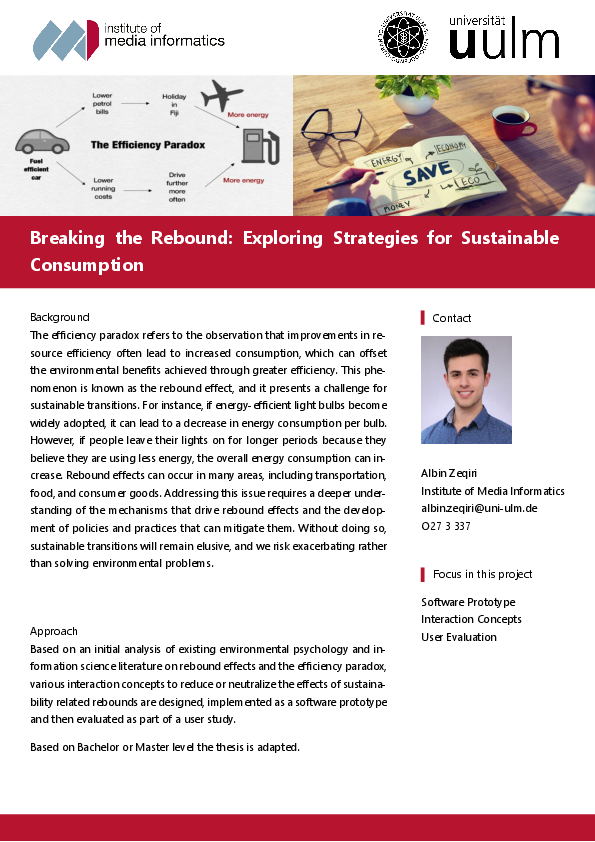
Breaking the Rebound: Exploring Strategies for Sustainable Consumption
Supervisor: Albin Zeqiri
Level: Bachelor & Master
The efficiency paradox (also known as "rebound effect") is the concept that increases in resource efficiency can lead to higher consumption, which offsets the environmental benefits. For example, energy-efficient light bulbs may lead to decreased energy consumption per bulb, but leaving them on for longer periods could increase overall energy consumption. Without addressing the issue, sustainable transitions will remain challenging, and environmental issues will persist or even worsen. The goal of theses on this topic is to design and evaluate countermeasures to mitigate these effects. Based on Bachelor or Master level the thesis is adapted.
Calm Technology and Digital Detox - How to nudge people towards a healthier technology usage
Supervisor: Luca-Maxim Meinhardt
Description
The first thing we do when we get up and the last thing we do before we go to sleep is to look at our phone to check for new notifications and search for new content on social media. Unfortunately, our dependence on technology is already so deeply integrated into our habits that we do not even realize how often we use our phones. On the one hand, this addiction harms us by being less focused due to distraction via notifications. Additionally, it is said that social media contributes to our attention span getting smaller. On the other hand, technology usage is also harming our social interactions during face-to-face interactions. For example, some people focus on their phones instead of engaging in a conversation, decreasing its quality. Recent trends in wearable technology, such as smartwatches and AR glasses, might even deteriorate this behavior. Therefore, new methods and interactions must be found to nudge people towards healthier technology usage and change their habits unconsciously.
Constant motion stimulus for peripherical vision to create Unconscious Notifications
Description The human peripherical vision provides us with information without shifting our focus from the primary task. This is particularly interesting since peripheral vision demands less cognitive load. So information that is positioned at the edge of the field of view can be received unconsciously without drawing attention. A prominent example is car driving since only a short moment of inattention might end in serious accidents. However, even daily struggles with loud and attention-drawing smartphone notifications that distract from working might be solved calmly with peripherical displays. In order to enable this concept, Augmented Reality glasses are the key since they provide us with wearable displays attached to our view.

Design Through My Eyes: Supporting Designers with a Vision Impairment Simulator Using Eye-Tracking
This thesis aims to create a desktop overlay simulation tool for visual impairment, designed to aid developers and designers in understanding the unique needs and experiences of visually impaired individuals. The project will involve developing a prototype simulation that can be applied across various design tasks, followed by a usability study to assess its effectiveness and impact on creating more accessible environments.
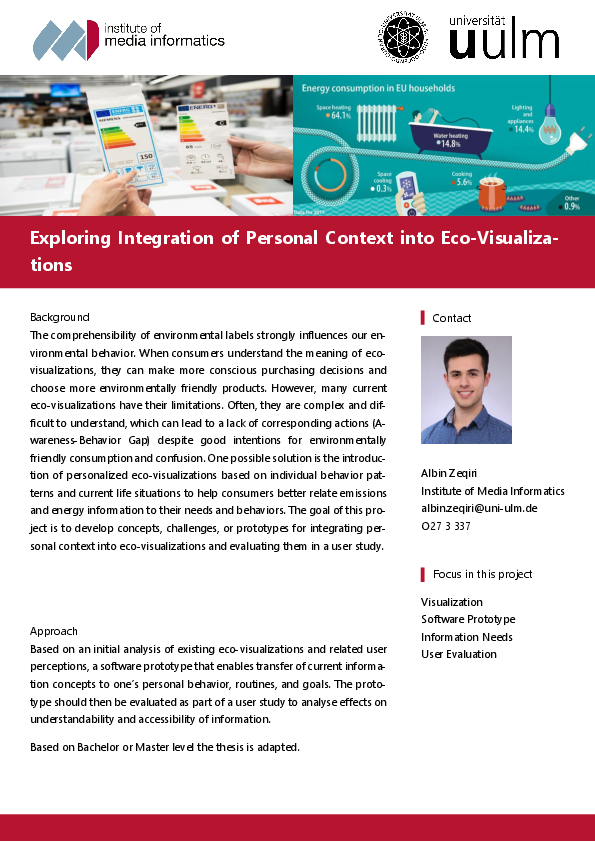
Exploring Integration of Personal Context into Eco-Visualizations
Environmental labels play a significant role in shaping our behavior towards the environment. Understanding the meaning of eco-visualizations can help consumers make informed and sustainable purchase decisions. However, current eco-visualizations are often complex and difficult to comprehend, leading to a lack of action and confusion among consumers. The Awareness-Behavior Gap describes this issue. Personalized eco-visualizations tailored to individual behavior patterns and lifestyles could be a solution to this problem. This project aims to develop concepts, prototypes, and solutions to integrate personalized context into eco-visualizations and evaluate their effectiveness in user studies.
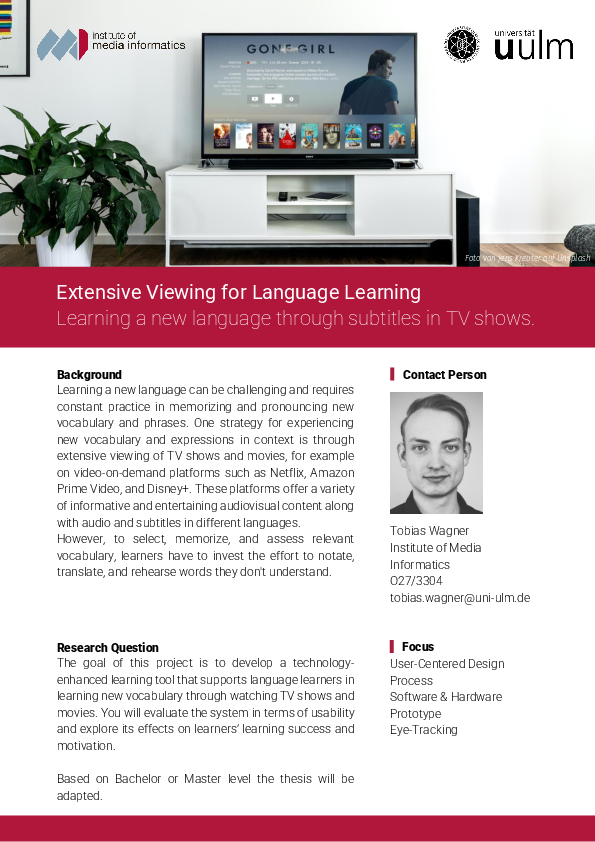
Extensive Viewing for Language Learning
Betreuer: Tobias Wagner
Beschreibung: The goal of this project is to develop a technology-enhanced learning tool that supports language learners in learning new vocabulary through watching TV shows and movies. You will evaluate the system in terms of usability and explore its effects on learners’ learning success and motivation.
Get Up, Stand Up - Put Down Your Phone - How to turn smartphone sessions into a sporty activity.
Supervisor: Luca Meinhardt and Jana Funke
Description: Based on literature research and related work, this thesis will aim for a solution to boost our self-control in phone usage. Our goal is to help people establish healthier smartphone usage by nudging them to do sports instead of browsing the phone.
Hello Me! – How Similarity and Mimicry of In-Vehicle Assistants Effect Trust in Highly Automated Vehicles
The aim of this work is to design and prototypically implement an in-vehicle avatar, which is able to adapt to the appearance of a passenger, for example by using DeepFake. The avatar should be further able to mimic the passenger. Subsequently, a user study should be conducted to evaluate whether similarity and mimicry have positive impacts on passengers trust in highly automated vehicles.
Immersive VR Guardians - Improving VR Gameplay through user-centered safety system design
Betreuer: Annalisa Degenhrad
Beschreibung: Have you ever played a VR game? Whenever you reach the boundary of your real-world play area (which quickly happens in average households), a grid will appear in front of you and will probably ruin your illusion of being in that fantastic VR world. The goal of this project will be to enhance built-in guardian systems for VR. In order to achieve this, you will focus on certain aspects of such systems and conduct a structured analysis to find out how these aspects could be improved to increase user experience. Possible aspects that you may focus on are the sensory representation of collision warnings, collision prevention systems or innovative customization mechanisms to match such systems with various VR worlds. Your goal will be to optimize guardian systems in terms of presence, usability, and safety in order to provide better VR experiences.
Implicit Interaction Concepts for Highly Automated Vehicles
The aim of this work is to design new implicit in-vehicle interaction concepts for highly automated vehicles (HAVs). These concepts should be implemented with Unity (in a driving simulator or VR environment). Subsequently, a user study should be conducted to evaluate whether those concepts have a positive influence on passengers’ trust, acceptance, and user experience in HAVs.
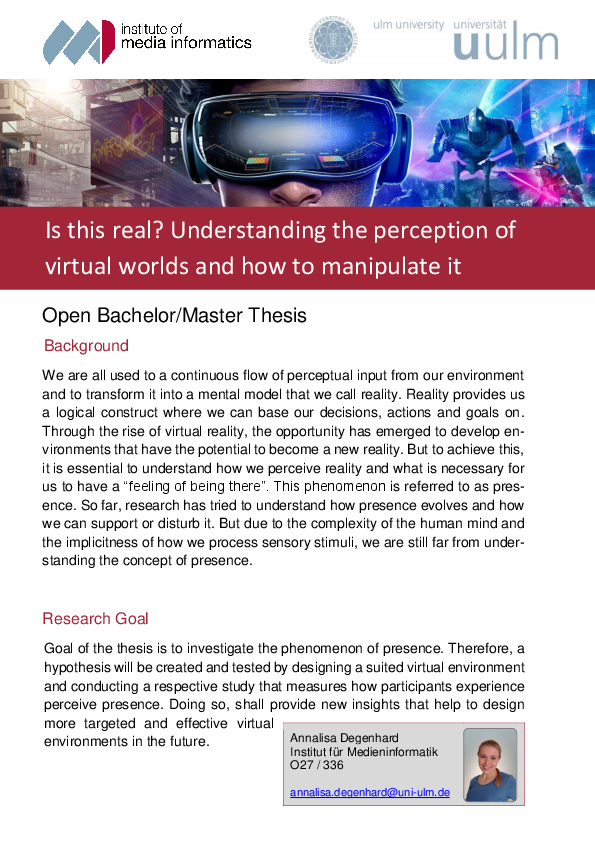
Is this real? Understanding the perception of virtual worlds and how to manipulate it
Supervisor: Annalisa Degenhard
The aim of this thesis is to explore the phenomenon of presence in virtual reality. A literature analysis should be conducted. By designing a suitable virtual environment a hypothesis on the behavior of presence will be tested in a user study. The goal is to get insights into how users perceive virtual environments and to draw conclusions on how they should be designed to improve the experience of virtual reality.
Lost in translation – Enhancing the explainability of online translators
Description Imagine the scenario that you need to translate a document in a foreign language that you are not familiar with. You will probably look for an online translator such as Google Translator or DeepL and just copy the translator’s output. But how can you trust this translation? How can you be sure that the translation is precisely what you are trying to say? Prominent examples are sayings that might have no meaning if translated word by word. But since you are not familiar with the language, you cannot verify if the online translator grasped the hidden meaning behind the saying. Current online translators lack this explainability. They provide multiple alternatives for the translated phrase, but there is no explanation about why these alternatives were shown and how well they suit the inputted text.
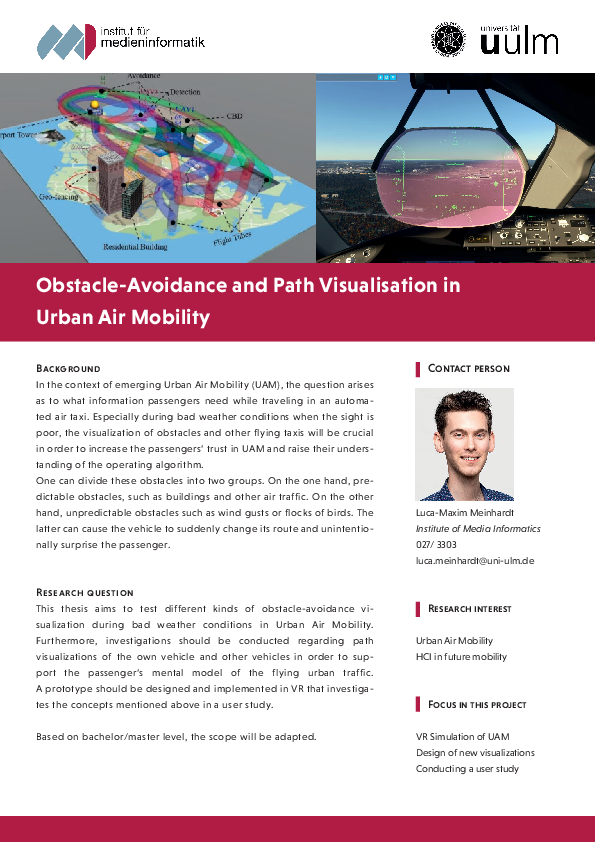
Obstacle-Avoidance and Path Visualisation in Urban Air Mobility
Description This thesis aims to test different kinds of obstacle-avoidance visualization during bad weather conditions in Urban Air Mobility. Furthermore, investigations should be conducted regarding path visualizations of the own vehicle and other vehicles in order to support the passenger‘s mental model of the flying urban traffic. A prototype should be designed and implemented in VR that investigates the concepts mentioned above in a user study.
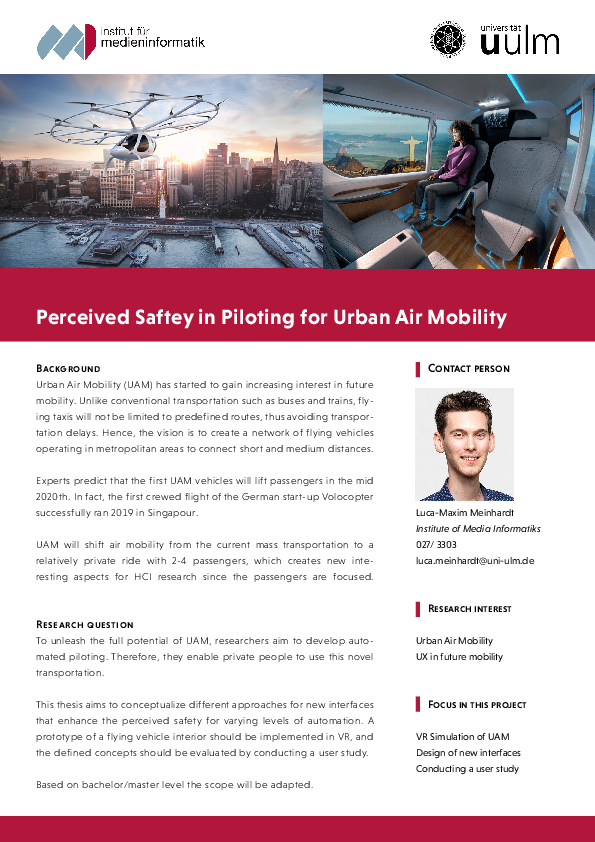
Perceived Safety in Piloting for Urban Air Mobility
Description: Urban Air Mobility (UAM) has started to gain increasing interest in future mobility. Unlike conventional transportation such as buses and trains, flying taxis will not be limited to predefined routes, thus avoiding transportation delays. Hence, the vision is to create a network of flying vehicles operating in metropolitan areas to connect short and medium distances. Experts predict that the first UAM vehicles will lift passengers in the mid 2020th. In fact, the first crewed flight of the German start-up Volocopter successfully ran 2019 in Singapour. UAM will shift air mobility from the current mass transportation to a relatively private ride with 2-4 passengers, which creates new interesting aspects for HCI research since the passengers are focused.
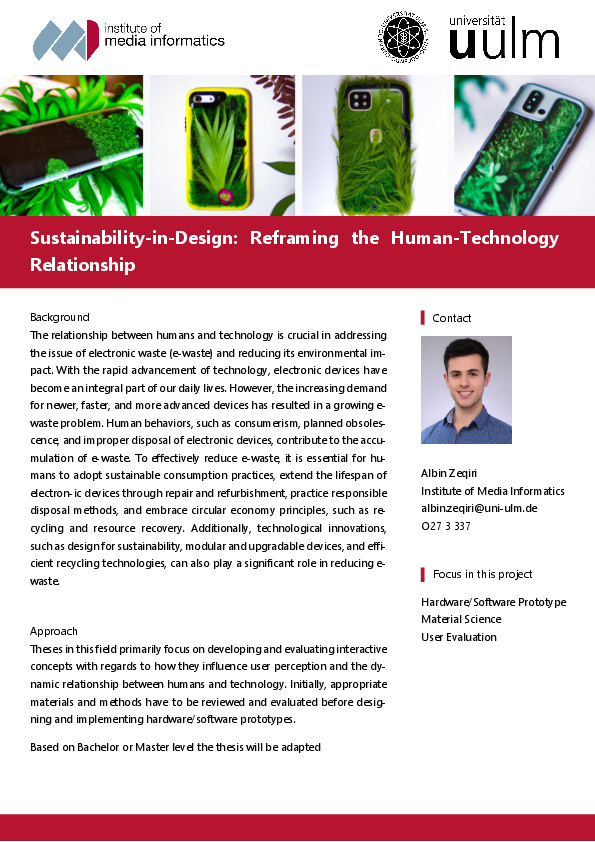
Sustainability-in-Design: Reframing the Human-Technology Relationship
Goals of theses in this area cover the development of new, interactive concepts that introduce living materials or even microorganisms into hardware and map its respective needs to various device functionalities. Based on bachelor or master level, the scope is adapted.
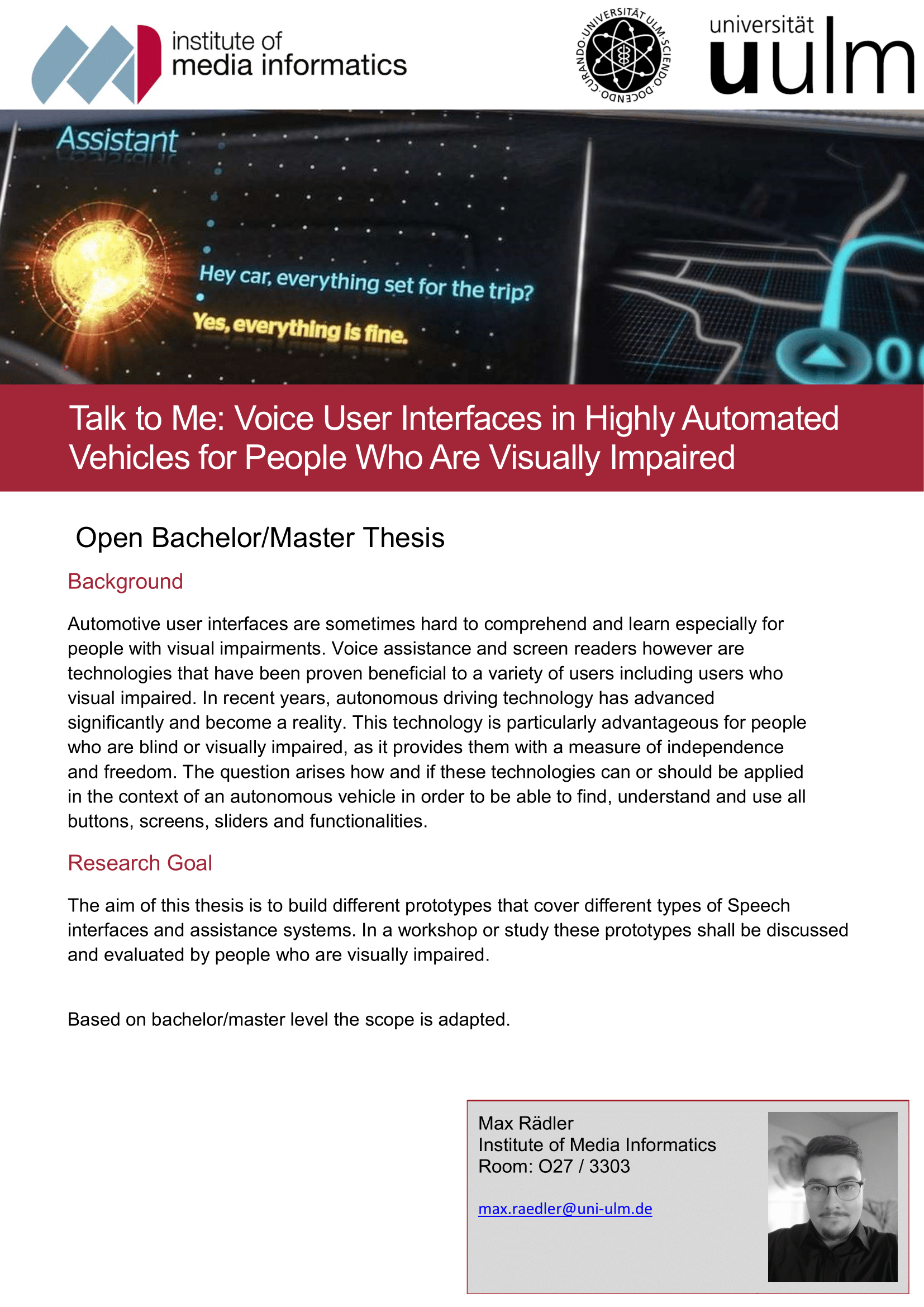
Talk to Me: Voice User Interfaces in Highly Automated Vehicles for People Who Are Visually Impaired
This thesis explores the integration of voice assistance and screen reader technologies in autonomous vehicle interfaces to enhance usability for visually impaired users. With advancements in autonomous driving providing increased independence for the blind and visually impaired, the focus here is on determining how these assistive technologies can be adapted for automotive use. This involves developing various prototypes of speech interfaces and assistance systems. The effectiveness and user-friendliness of these prototypes will be assessed through workshops or studies involving visually impaired participants, aiming to ensure that all vehicle controls are accessible and comprehensible.
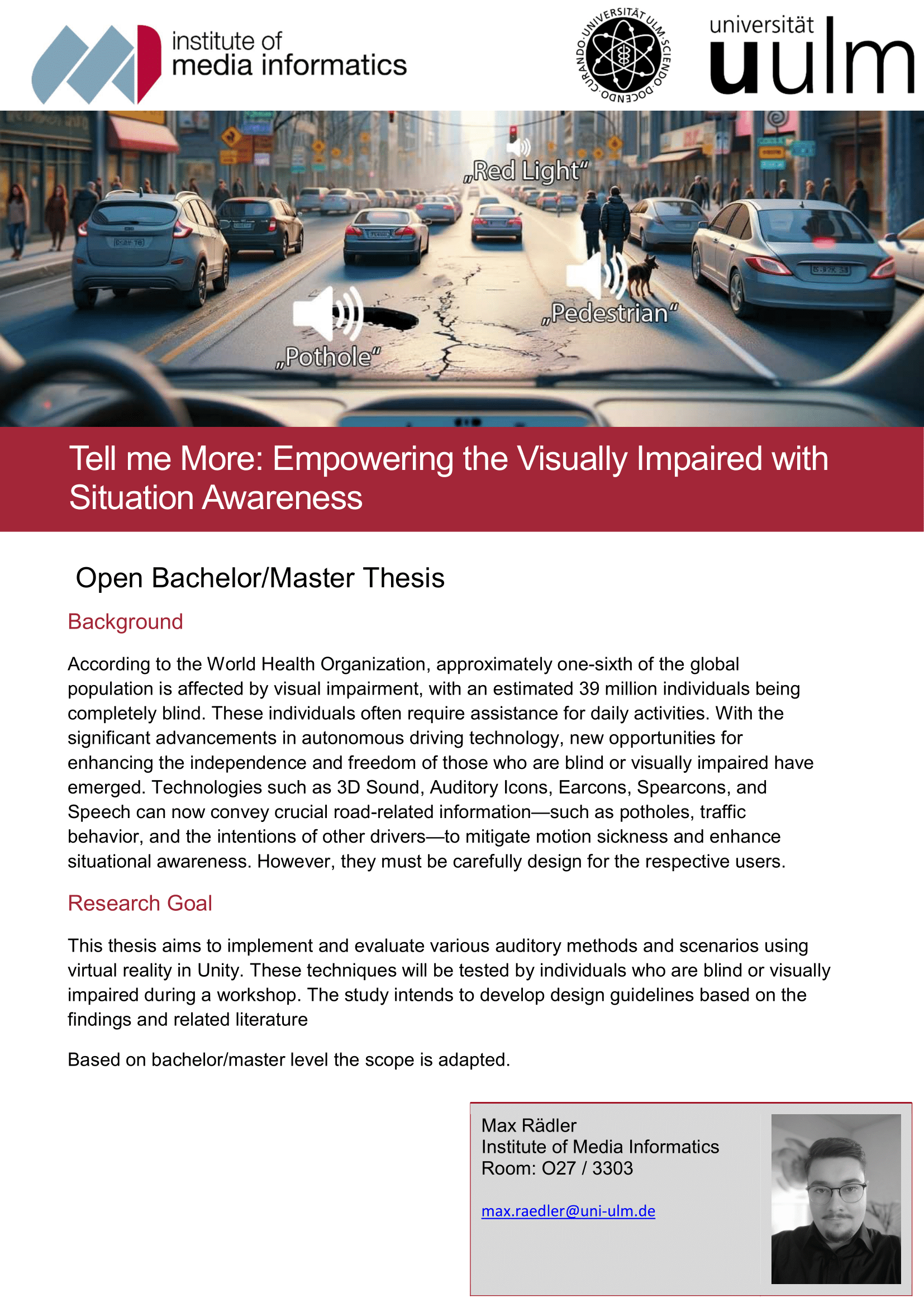
Tell me More: Empowering the Visually Impaired with Situation Awareness
This thesis focuses on utilizing auditory technologies such as 3D Sound and Earcons in autonomous vehicles to aid visually impaired individuals. With significant advancements in autonomous driving, these technologies can enhance situational awareness by conveying essential road information. This project will implement these auditory methods in Unity's virtual reality environment and evaluate their effectiveness through a workshop with visually impaired participants. The study aims to develop practical design guidelines based on the findings and existing literature.
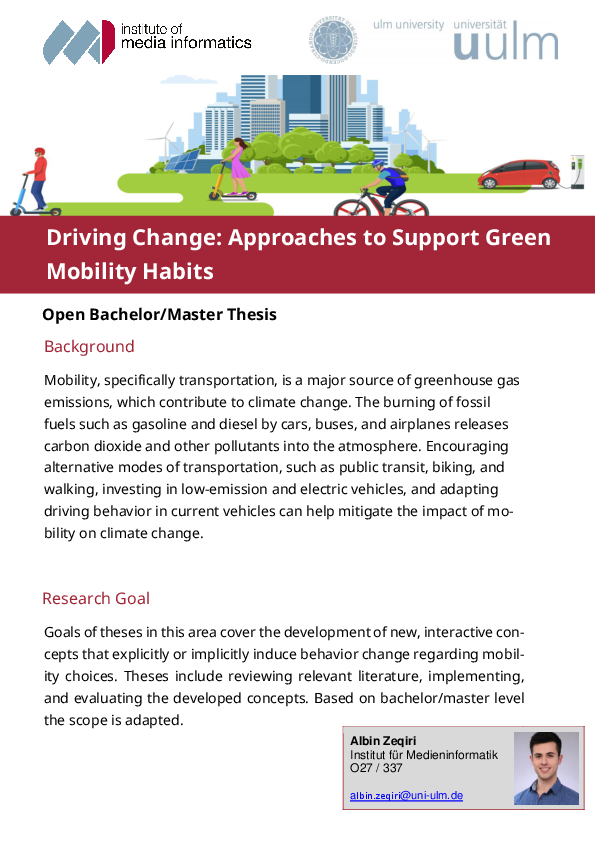
Driving Change: Approaches to Support Green Mobility Habits
Level: Bachelor
Goals of theses in this area cover the development of new, interactive concepts that explicitly or implicitly induce behavior change regarding mobility choices. Theses include reviewing relevant literature, implementing, and evaluating the developed concepts. Based on bachelor/master level the scope is adapted.
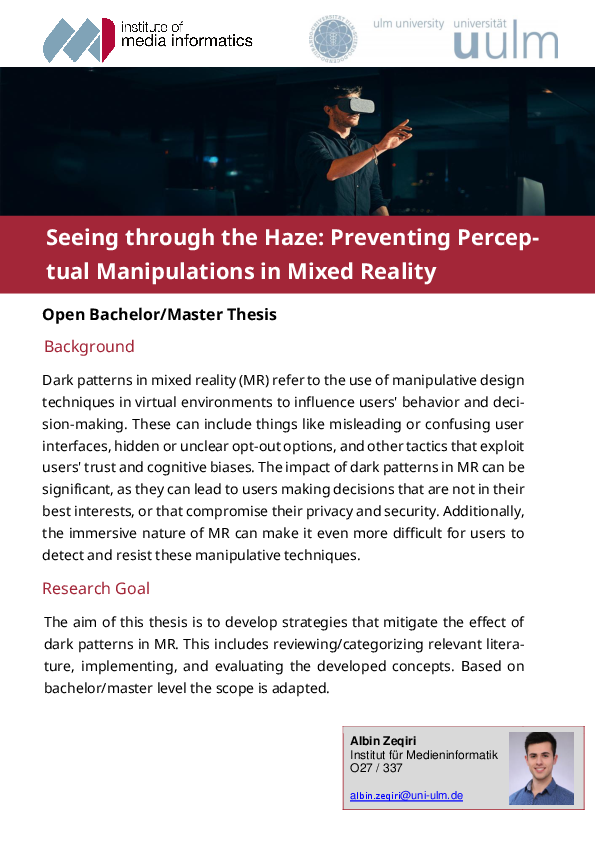
Seeing through the Haze: Preventing Perceptual Manipulations in Mixed Realit
The aim of this thesis is to develop strategies that mitigate the effect of dark patterns in MR. This includes reviewing/categorizing relevant literature, implementing, and evaluating the developed concepts. Based on bachelor/master level the scope is adapted

Funding Partners Publications Awards
Projects Topics for bachelor and master theses
German Pre-CHI Event 2022
- DSpace@MIT Home
- MIT Libraries
- Doctoral Theses
Olfactory interfaces : toward implicit human-computer interaction across the consciousness continuum

Alternative title
Other contributors, terms of use, description, date issued, collections.
Show Statistical Information
The impact of near-peer virtual agents on computer science attitudes and collaborative dialogue
New citation alert added.
This alert has been successfully added and will be sent to:
You will be notified whenever a record that you have chosen has been cited.
To manage your alert preferences, click on the button below.
New Citation Alert!
Please log in to your account
Information & Contributors
Bibliometrics & citations, view options, recommendations, accessible multimodal-interaction platform for computer-supported collaborative learning system.
In order to facilitate learning in the context of social interactions, a number of studies have proposed computer-supported collaborative learning (CSCL) systems by using information and communication technologies. The basic design of a CSCL system is ...
Inferring interaction to support collaborative learning in 3D virtual environments through the user's avatar Non-Verbal Communication
When a group of students, placed around a shared workspace and working on a predefined task, is observed, the teacher can intuitively, to a certain extent, understand the collaboration that is taking place within the group without listening to the ...
Designing for collaborative learning in immersive virtual reality: a systematic literature review
Immersive learning technologies such as virtual reality have long been deemed as the next generation of digital learning environments. There is a limited number of studies addressing how immersive technologies can be designed, applied, and studied ...
Information
Published in.
Elsevier Science Publishers B. V.
Netherlands
Publication History
Author tags.
- Virtual learning companions
- Elementary school
- Computer science learning
- Collaborative learning
- Research-article
Contributors
Other metrics, bibliometrics, article metrics.
- 0 Total Citations
- 0 Total Downloads
- Downloads (Last 12 months) 0
- Downloads (Last 6 weeks) 0
View options
Login options.
Check if you have access through your login credentials or your institution to get full access on this article.
Full Access
Share this publication link.
Copying failed.
Share on social media
Affiliations, export citations.
- Please download or close your previous search result export first before starting a new bulk export. Preview is not available. By clicking download, a status dialog will open to start the export process. The process may take a few minutes but once it finishes a file will be downloadable from your browser. You may continue to browse the DL while the export process is in progress. Download
- Download citation
- Copy citation
We are preparing your search results for download ...
We will inform you here when the file is ready.
Your file of search results citations is now ready.
Your search export query has expired. Please try again.
IEEE Account
- Change Username/Password
- Update Address
Purchase Details
- Payment Options
- Order History
- View Purchased Documents
Profile Information
- Communications Preferences
- Profession and Education
- Technical Interests
- US & Canada: +1 800 678 4333
- Worldwide: +1 732 981 0060
- Contact & Support
- About IEEE Xplore
- Accessibility
- Terms of Use
- Nondiscrimination Policy
- Privacy & Opting Out of Cookies
A not-for-profit organization, IEEE is the world's largest technical professional organization dedicated to advancing technology for the benefit of humanity. © Copyright 2024 IEEE - All rights reserved. Use of this web site signifies your agreement to the terms and conditions.
Human-Computer Interaction Master of Science Degree

Request Info about graduate study Visit Apply
In the human-computer interaction master's degree, you'll study how people interact with websites, computer systems, and software, enabling you to create intuitive interfaces that improve how we interact with and use emerging technologies.
Outcomes Rate of RIT Graduates from this degree
Average First-Year Salary of RIT Graduates from this degree
Growth in demand for user research
Overview for Human-Computer Interaction MS
Explore the design methods, evaluation, and implementation of interactive computing systems for human use. Building on decades of research in psychology and human behavior, the human-computer interaction master’s degree focuses on the skills needed by user-experience researchers and computing professionals, including observing how people interact with websites and software and the design new technologies to help them accomplish their goals. With computing moving rapidly away from the traditional desktop, companies need professionals that understand how evolving technologies can be designed to be intuitive, effective, and compelling for users.
RIT’s Human-Computer Interaction Master’s Degree: On-Campus or Online
Human-computer interaction (HCI) addresses the design, evaluation, and implementation of interactive computing and computing-based systems for the benefit of human use. HCI research is driven by technological advances and the increasing pervasiveness of computing devices in our society. With an emphasis on making computing technologies more user-friendly, HCI has emerged as a dynamic, multifaceted area of study that merges theory from science, engineering, and design—as well as concepts and methodologies from psychology, anthropology, sociology, and industrial design—with the technical concerns of computing.
The human-computer interaction master’s degrees provides the knowledge and skills necessary for conceptualizing, designing, implementing, and evaluating software applications and computing technologies for the benefit of the user, whether the user is an individual, a group, an organization, or a society. Human, technological, and organizational concerns are interwoven throughout the curriculum and addressed in team- and project-based learning experiences.
Human-Computer Interaction Curriculum: Packed with High-Demand Skills
- Research: Demand for user research skills is growing 35%, and carries a competitive advantage in the marketplace.
- UI/UX: Information architecture skills carry a salary premium in the workforce.
- Design Thinking: Demand for design thinking skills is growing 112%.
- Development: Demand for front-end development skills is growing 12% and carries a salary premium.
Human-Computer Interaction Master's Courses
The core courses provide knowledge and skills in the conceptual and methodological frameworks of HCI and HCI research. Emphasis is on understanding human cognition as it applies to information systems plus interaction design, interface prototyping, and usability evaluation.
Program Electives: Students select two elective courses. In select cases, students can petition for approval to include a course complementary to the degree program as a program elective.
Application Domain Courses:To gain breadth in a technical area to which HCI concepts can be applied, students complete two courses in any of the application domain areas. A special topics option is also available, with faculty approval, for individuals with interest in other HCI-related areas.
- e-Learning Technologies –The recent boom in online learning has created a need for professionals to design such systems. Students learn the fundamentals of instructional technology and interactive courseware.
- Geographical Information Science and Technology –Research how digital technology is revolutionizing how humans view earth with topics in thematic cartography and geographic visualization.
- Self-defined Application Domain –Design your own concentration.
- Smart Device Application Design and Development –Smart devices are no longer limited to phones. Design and study human interaction with cutting-edge mobile technology.
- Web Development –Study the foundations of web technologies, enabling students to better understand how The Internet can be built to improve the experience of a diverse range of end-users.
Thesis/Capstone Project: Students may complete a thesis or capstone project. This experience is meant to be an empirical study of a HCI problem, which can be the development of a software product through user-centered design processes. The results are either published in a peer-reviewed journal or publicly disseminated in an appropriate professional venue.

Join us for Fall 2024
Many programs accept applications on a rolling, space-available basis.
Learn what you need to apply

30% Tuition Scholarship for NY Residents and Graduates
Now is the perfect time to earn your Master’s degree. If you’re a New York state resident with a bachelor’s degree or have/will graduate from a college or university in New York state, you are eligible to receive a 30% tuition scholarship.
Learn more about Master Up NY
Careers and Experiential Learning
Typical job titles.
| User Experience Researcher | UI/UX Designer | Interaction Designer |
| Usability Specialist | Entrepreneur | Frontend Developer |
| Mobile Applications Designer | Product Designer | Research Associate |
| Senior Software Engineer | UX/UI Developer |
Cooperative Education
What makes an RIT education exceptional? It’s the ability to complete relevant, hands-on career experience. At the graduate level, and paired with an advanced degree, cooperative education and internships give you the unparalleled credentials that truly set you apart. Learn more about graduate co-op and how it provides you with the career experience employers look for in their next top hires.
Cooperative education is optional but strongly encouraged for graduate students in the human-computer interaction program.
Creative Industry Day
RIT’s Office of Career Services and Cooperative Education hosts Creative Industry Day , which connects students majoring in art, design, film and animation, photography, and select computing majors with companies, organizations, creative agencies, design firms, and more. You'll be able to network with company representatives and interview directly for open co-op and permanent employment positions.
Featured Work and Profiles

Usability, Accessibility and Social Entanglements in Advanced Tool Use by Vision Impaired Graduate Students
Kristen Shinohara
iSchool Profs. Kristen Shinohara and Michael McQuaid (now at University of Texas, Austin), Ph.D. student Murtaza Tamjeed, and MS HCI student Dymen A, Barkins recently published “Usability,...
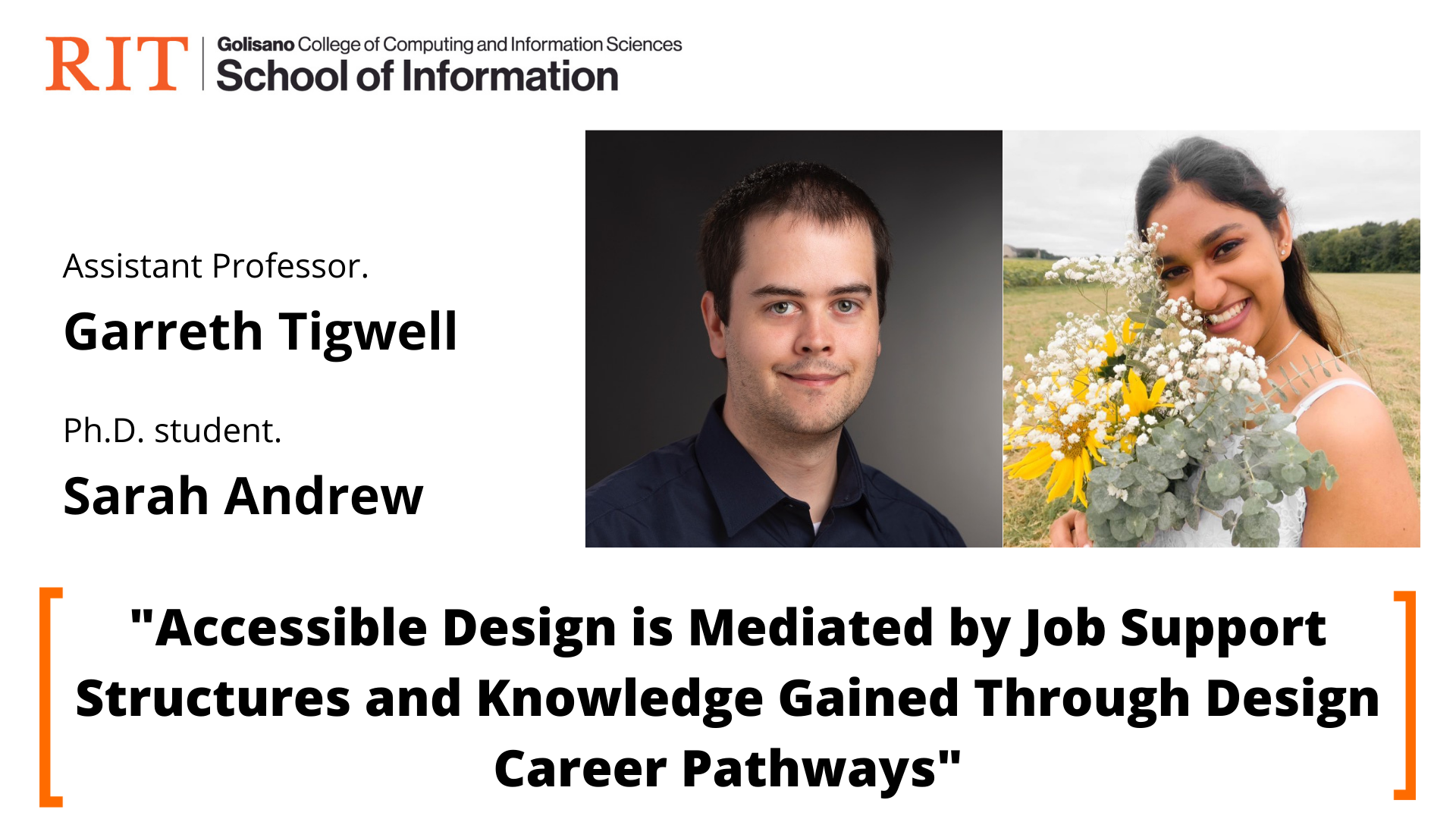
Accessible Design is Mediated by Job Support Structures and Knowledge Gained Through Design Career Pathways
Garreth Tigwell
Ph.D. student Sarah Andrew and Prof. Garreth Tigwell published “Accessible Design is Mediated by Job Support Structures and Knowledge Gained Through Design Career Pathways” for the 25th ACM Conference...

Caption Mask
Caption Mask is one of the famous booths in ImagineRIT 2022. The caption mask project started in the classroom and they presented in the hospital and showing the possibility of their research in the...

One Button PIN: A Single Authentication Method for Blind and Low Vision Users
Garreth Tigwell, Roshan Peiris
Prof. Garreth Tigwell, Prof. Roshan Peiris, and their team won the Best Paper Award at Mobile HCI 2022!

A Lasting Impact in Accessibility and Usability
Faculty Emerita Vicki Hanson
Although Vicki Hanson stepped away from her full-time faculty role within the School of Information more than three years ago and has since become the Chief Executive Officer of the Association for...
Curriculum for 2024-2025 for Human-Computer Interaction MS
Current Students: See Curriculum Requirements
Human-Computer Interaction (capstone project option), MS degree, typical course sequence
| Course | Sem. Cr. Hrs. | |
|---|---|---|
| HCIN-600 | 3 | |
| HCIN-610 | 3 | |
| HCIN-620 | 3 | |
| HCIN-630 | 3 | |
| HCIN-794 | 3 | |
| 6 | ||
| 3 | ||
| HCIN-795 | 3 | |
| 3 | ||
Human-Computer Interaction (thesis option), MS degree, typical course sequence
| Course | Sem. Cr. Hrs. | |
|---|---|---|
| HCIN-600 | 3 | |
| HCIN-610 | 3 | |
| HCIN-620 | 3 | |
| HCIN-630 | 3 | |
| 6 | ||
| 6 | ||
| HCIN-796 | 6 | |
Human-Computer Interaction (directed final project option*), MS degree, typical course sequence
| Course | Sem. Cr. Hrs. | |
|---|---|---|
| HCIN-600 | 3 | |
| HCIN-610 | 3 | |
| HCIN-620 | 3 | |
| HCIN-630 | 3 | |
| 6 | ||
| 6 | ||
| HCIN-797 | 3 | |
| 3 | ||
* Directed Final Project Option is for online students.
Application domain courses
E-learning technologies.
| Course | |
|---|---|
| HCIN-660 | |
| HCIN-661 | |
Geographic information science and technology
| Course | |
|---|---|
| IGME-770 | |
| IGME-772 | |
Smart device application design and development
| Course | |
|---|---|
| HCIN-720 | |
| HCIN-722 | |
Web development
| Course | |
|---|---|
| ISTE-645 | |
| ISTE-646 | |
Program electives
| Course | |
|---|---|
| HCIN-660 | |
| HCIN-661 | |
| HCIN-662 | |
| HCIN-663 | |
| HCIN-700 | |
| HCIN-720 | |
| HCIN-722 | |
| HCIN-730 | |
| HCIN-794 | |
| IGME-770 | |
| IGME-772 | |
| ISTE-645 | |
| ISTE-646 | |
| ISTE-730 | |
| ISTE-732 | |
| ISTE-764 | |
| ISTE-782 | |
| MEDI-701 | |
| PSYC-712 | |
| PSYC-715 | |
Note for online students
The frequency of required and elective course offerings in the online program will vary, semester by semester, and will not always match the information presented here. Online students are advised to seek guidance from the listed program contact when developing their individual program course schedule.
Students are also interested in
- Experimental Psychology MS
- Visual Communication Design MFA
Admissions and Financial Aid
This program is available on-campus or online.
| Offered | Admit Term(s) | Application Deadline | STEM Designated |
|---|---|---|---|
| Full-time | Fall or Spring | Fall - February 15 priority deadline, rolling thereafter; Spring - rolling | Yes |
| Part-time | Fall or Spring | Rolling | No |
| Offered | Admit Term(s) | Application Deadline | STEM Designated |
|---|---|---|---|
| Part-time | Fall or Spring | Rolling | No |
Full-time study is 9+ semester credit hours. Part-time study is 1‑8 semester credit hours. International students requiring a visa to study at the RIT Rochester campus must study full‑time.
Application Details
To be considered for admission to the Human-Computer Interaction MS program, candidates must fulfill the following requirements:
- Complete an online graduate application .
- Submit copies of official transcript(s) (in English) of all previously completed undergraduate and graduate course work, including any transfer credit earned.
- Hold a baccalaureate degree (or US equivalent) from an accredited university or college.
- A recommended minimum cumulative GPA of 3.0 (or equivalent).
- Satisfy prerequisite requirements and/or complete bridge courses prior to starting program coursework.
- Submit a current resume or curriculum vitae.
- Submit a personal statement of educational objectives .
- Submit two letters of recommendation .
- Entrance exam requirements: GRE required for individuals with degrees from international universities. No minimum score requirement.
- Writing samples are optional.
- Submit English language test scores (TOEFL, IELTS, PTE Academic), if required. Details are below.
English Language Test Scores
International applicants whose native language is not English must submit one of the following official English language test scores. Some international applicants may be considered for an English test requirement waiver .
| TOEFL | IELTS | PTE Academic |
|---|---|---|
| 88 | 6.5 | 60 |
International students below the minimum requirement may be considered for conditional admission. Each program requires balanced sub-scores when determining an applicant’s need for additional English language courses.
How to Apply Start or Manage Your Application
Cost and Financial Aid
An RIT graduate degree is an investment with lifelong returns. Graduate tuition varies by degree, the number of credits taken per semester, and delivery method. View the general cost of attendance or estimate the cost of your graduate degree .
A combination of sources can help fund your graduate degree. Learn how to fund your degree
Additional Information
Prerequisites.
The program requires strong technical and social science skills. Knowledge of quantitative statistical methodologies is important since students review research studies as well as analyze the results of their own usability evaluations. Students are also expected to have a solid background in computer programming. These competencies may be demonstrated by previous course work, technical certifications, or comparable work experience. Bridge courses are available to fulfill any gaps in an applicant's qualifications. Applicants will be made aware of any areas where additional course work may be necessary.

Online Degree Information
The Human-Computer Interaction MS program is designed to be completed part-time (1 or 2 courses per term). Full-time options may be available with Graduate Program Director's approval. Time to completion will depend on the student’s individual plan of study, when courses are offered, what electives are selected, and if the student takes a summer course. Advisors work closely with students after admission on course registration. Typically students finish this degree in 2 years. For specific details about the delivery format and learning experience, contact the Program Contact listed on this page. RIT does not offer student visas for online study.
Online Tuition Eligibility The online Human-Computer Interaction MS is a designated online degree program that is billed at a 43% discount from our on-campus rate. View the current online tuition rate .
Online Study Restrictions for Some International Students
Certain countries are subject to comprehensive embargoes under US Export Controls, which prohibit virtually ALL exports, imports, and other transactions without a license or other US Government authorization. Learners from the Crimea region of the Ukraine, Cuba, Iran, North Korea, and Syria may not register for RIT online courses. Nor may individuals on the United States Treasury Department’s list of Specially Designated Nationals or the United States Commerce Department’s table of Deny Orders. By registering for RIT online courses, you represent and warrant that you are not located in, under the control of, or a national or resident of any such country or on any such list.

Catherine Beaton

Elissa Weeden
Related News
February 15, 2024
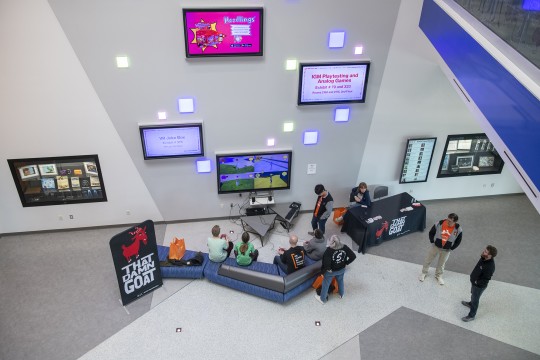
Inside the making of 'That Damn Goat,' RIT's latest video game
Chaos is the only constant in "That Damn Goat," a party, "anti-Covid" video game made by around 60 RIT faculty, students and staff. The project was led by School of Film and Animation faculty Brian Larson (creative director) and Jesse O'Brien (art director).
August 14, 2023
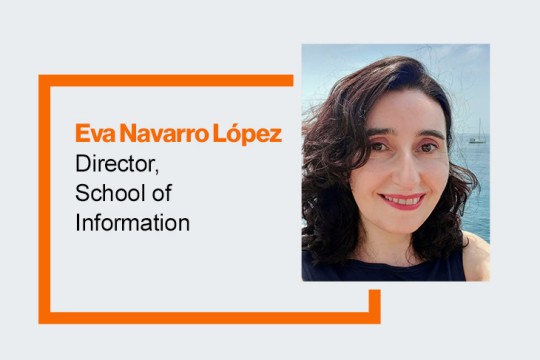
Eva Navarro López named School of Information Director
Eva Navarro López has been named director of the School of Information in RIT’s Golisano College of Computing and Information Sciences.
April 3, 2023

RIT Master Plan gives graduate tuition scholarship to eligible alumni
RIT is offering a graduate tuition scholarship to recent alumni seeking to expand their career potential through the university’s graduate programs. Alumni can enhance their skill set for the new economy through master’s degrees that build upon collaboration, analytical thinking, complex problem solving, and flexibility.

If you are interested in finishing your Bachelor or Master studies with a thesis in Human-Computer Interaction, you are welcome to contact us. Our research projects are a rich source for ideas. In general, writing a thesis with a focus on HCI will require you to take a user-centred perspective and asks you to apply adequate methods, such as involving users during design and evaluation. But at the same time, you will have the chance to work with the latest technology, such as Augmented Reality Glasses, Gaze-Based Interaction, Multi-Device Interaction, Voice Assistants, or other novel interaction techniques.
Our research topics are concerned with Collaborative Work Spaces and Human-Robot Interaction. Take a look at our research project pages - there is always room for a bachelor or master thesis. Get inspired here .
You have your own idea? Please, let us know! We are always looking for new topics to expand to.

Interested in a thesis topic?
Completed theses.
Dierks, Tim Visual Cues: Integration of object pose recognition with an augmented reality system as means to support visual perception in human-robot control AbschlussarbeitMIA Westfälische Hochschule, Neidenburger Straße 43, 45897 Gelsenkirchen, 2020. | | Links:
|
Ruecker, Franziska Visuelle Helfer: Ein Augmented Reality Prototyp zur Unterstützung der visuellen Wahrnehmung für die Steuerung eines Roboterarms AbschlussarbeitMIA Westfälische Hochschule, Neidenburger Straße 43, 45897 Gelsenkirchen, 2020. | | Links:
|
Sandkühler, Christian Konzeption, Implementierung und Evaluation eines Metadaten-Repositorys in Form einer Web-Applikation Bachelor Thesis Westphalian University of Applied Sciences, 2020.
|
Köckerling, Jonas Empathische Musik: Verwenden des emotionalen Zustands des Benutzers zur Optimierung von KI-generierten Playlisten Bachelor Thesis Westphalian University of Applied Sciences, 2019.
|
Kronhardt, Kirill Konzeption, prototypische Umsetzung und Evaluation alternativer Benutzeroberflächen für die Arbeitssuche am Beispiel der Stellenplattform jobvector.de Bachelor Thesis Westphalian University of Applied Sciences, 2019.
|
Hülscher, Nico Konzeption und Entwicklung eines Sprachassistenten für den Einsatz in der Pflege Bachelor Thesis Westphalian University of Applied Sciences, 2019.
|
Krause, Thiemo Machbarkeitsstudie zur Umsetzung von Kreativitätsmethoden in Augmented-Reality am Beispiel der Affinity-Diagramm Methode Bachelor Thesis Westphalian University of Applied Sciences, 2018.
|
Becker, Marvin Konzeption und Entwicklung eines „Mixed Reality Whiteboard“ mit der Microsoft Hololens Bachelor Thesis Westphalian University of Applied Sciences, 2018.
|
Ihmig, Maike Ursachen und Möglichkeiten zur Vorbeugung von Cybersickness am Beispiel der Virtual Reality Software ZOOMission Bachelor Thesis Westphalian University of Applied Sciences, 2018.
|
Kwiedor, Markus Konzipierung und Entwicklung einer Webanwendung zur Darstellung freier Wohnlageninformationen basierend auf openData Abschlussarbeit Westphalian University of Applied Sciences, 2018.
|
Terbeck, Clara Analyse, Konzeption und Entwicklung eines Chatbots auf Basis eines Frameworks für die Unterstützung von Studierenden im Hochschulalltag Bachelor Thesis Westphalian University of Applied Sciences, 2018, (Bachelor Thesis).
|
Klomfaß, Yvonne Interaktionsdesign und Implementierung einer mittels Handgesten gesteuerten Anwendung für die Arzneimittelherstellung Bachelor Thesis Westphalian University of Applied Sciences, 2018.
|
Akdere, Esra Gestaltung und Evaluation einer Benutzeroberfläche für eine blickbasierte PC-Steuerung am Beispiel eyeV Bachelor Thesis Westphalian University of Applied Sciences, 2017.
|
Sprenger, Daniel Stand, Trends und Analyse von Anzeige- und Bedienelementen im Elektrokraftfahrzeug Bachelor Thesis Westphalian University of Applied Sciences, 2016.
|
- Zur Metanavigation
- Zur Hauptnavigation
- Zur Subnavigation
- Zum Seitenfuss
Photo: HCI, ilikeinterfaces.com
General Information
Writing and defending your thesis is last step in your current study. It might be the most important puzzle of your future career. Hence, you should really think about it and find an appropriate topic, which you will get passionate about.
How to write a thesis at the Human-Computer Interaction group
When to start.
- Start thinking about your bachelor’s and master’s thesis when you are about halfway through your studies. If you are interested in writing your thesis in the HCI group, attend some lectures we offer (Interaction Design, Usability Engineering & User Experience Design, Bachelor Project, Bachelor Practical Course).
- Please attend at least 2–3 courses, especially the project or practical course, to gain enough knowledge about our research field and the technologies we use.
- Usually, you can start working on your thesis during your final year, although an earlier start would also be possible.
How to find a topic
- On our website, we offer open topics. Before accessing the open topics, please complete a quick test to check if these topics are appropriate to you based on your skills and knowledge.
- Even if you do not find a suitable topic on the website, you can take a look at our group members' websites . Here, you will find information about each person's research interest.
- Otherwise, you can come up with your own topic idea. Especially courses like the Bachelor Project could give you an idea about what we are researching, and some ideas about possible topics.
How to find a supervisor and reviewers
- Usually, one of our group members will supervise your thesis. With your supervisor you will stay in contact during your thesis to discuss your progress regularly.
- Additionally, you have to find two reviewers who will review and grade your thesis. Usually, Prof. Dr. Steinicke would be the first reviewer and your supervisor would be the second one.
- If you want to work on a topic provided on the website, contact the responsible person listed there.
- Otherwise, try to find one of our group members, whose research area you think fits your topic idea. You can get to know our research areas by attending our courses or by checking our websites .
- Write an email to one of the group members. Please do not contact everyone at once. If the person you contacted thinks that another person would fit better, they will handle it and forward your request accordingly.
- Your study program / degree
- Relevant courses you have taken, your relevant skills (programming, AR/VR experience, …), work experience, statistics…
- Your topic idea
- Ask if your topic would fit and if the person would be available to supervise your thesis.
How to start writing a thesis
- Once you and your supervisor have agreed on a topic, it is time to familiarize yourself with the topic. Start reading literature and find a narrower research topic. Discuss this with your supervisor.
- Do a literature search. Read relevant literature in detail, identify the aspects you want to focus on, and understand possible research methods and study designs.
- Plan your research questions, hypotheses, motivation, study design, and possible measures. Discuss it with your supervisor.
- After the agreement on your topic with your supervisor, schedule a meeting in the office hours of Prof. Dr. Steinicke with your supervisor. Come prepared to that meeting to explain your research focus in max. 5 minutes.
- Discuss the registration of your thesis with your supervisor.
How to actually write the thesis
- For writing the thesis, we strongly recommend using LaTeX. You can find a template at the bottom of this page.
- The thesis can be written either in english or in german.
- Typical thesis includes introduction, related work, implementation, user study (including hypotheses, methods, results and discussion), limitations and conclusion sections. However, this might be subject to your thesis topic.
How to develop an application and run a study
- Most likely, you will develop an application using the Unity engine (for some topics also other technologies and software might be useful).
- In our field, we are interested in understanding how humans interact with digital systems and how systems can be designed to meet the users’ needs. Therefore, during your thesis, you will most likely run a user study to collect data.
- You will use git for version control. This way, you always have your work backed up and can easily share it between devices. Please remember that lab computers are not a permanent place to store your data. If you do not back up your data or your project from these computers online (git or a cloud service), it might get deleted. Also, do not store backups on these computers themselves - they will definitely be deleted.
- Before you run your study, please test your implementation first yourself and then with people from your close circle. Afterward, present your final implementation to your supervisor to receive feedback.
- Studies have to be prepared carefully. Ask your supervisor to get necessary information about ethics, consent forms, how to invite participants, which room to book and more.
- Correctly saving data during studies is crucial. Record mock data or pilot your study to verify that your data acquisition works as expected.
- Plan your data analysis before running the study. Run the analysis on your mock or pilot data to verify the data acquisition.
- Finalize the preparation of your study material and present it to your supervisor for final approval.
- Run your study.
- Perform the analysis and report your results in the written thesis.
How to finish your thesis
- For information on how to submit your thesis, please read the Academic Office’s website .
- Besides submitting the written thesis, you will be required to defend your thesis in a colloquium. Here, you will present your work and answer questions from the audience (especially your supervisor and reviewers).
- For a Bachelor’s thesis, your presentation should last 15 minutes; for a Master’s thesis, it should last 20 minutes. The presentation will be followed by around 5 minutes for questions and discussion.
- The colloquium can take place shortly before or after the submission of your thesis. Approach your supervisor in time to arrange a date.
Helpful Links
Open Topics
We have a variety of interesting topics in the area of human-computer interaction. However, you need certain qualifications and abilities, which you should have learned in some of our courses. If you do not have these skills, our open thesis topics will not be appropriate for you, but will rather frustrate you, and therefore we will not recommend to write your thesis in our group.
We prepared a short test, in which you can check your knowledge. After successful completion, you will be forwarded to our open topics.
To see the available topics directly, just click here:
Example LaTeX template
Completed Thesis
Publications in 2024, publications in 2023, publications in 2022, publications in 2021, publications in 2020, publications in 2019, publications in 2018, publications in 2017, publications in 2016, publications in 2015, publications in 2014, publications in 2013, publications in 2012, publications in 2011, publications in 2010, publications in 2009, publications in 2008, publications in 2007, publications in 2006, publications in 2005, publications in 2004, publications in 2003, publications in 2001, publications in 2000, publications in 1999, publications in 1998, publications in 1997, publications in 1996, publications in 1995, publications in 1994, publications in 1993, publications in 1992, publications in 1991, publications in 1990, publications in 1989, publications in 1988, publications in 1987, publications in 1985, publications in 1984, publications in 1983.
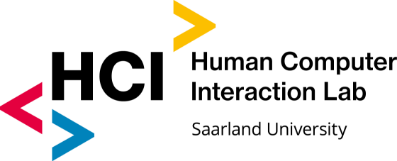
- Publications
Thesis (Extended)
Theses (extended).
This page contains the most important information about doing your thesis in the HCI lab. It describes our structured process of helping you write a strong thesis within the time frame foreseen in your study program. Our experience is that this structure is a good guide for students to ask the right questions, stay on track, focus on the tasks that are most relevant in a given phase of thesis work, etc. However, this is not a rigid structure — there may be many good reasons to make adjustments –, and in every individual thesis, we find a workflow and process that matches the specific topic and student’s needs. All throughout the thesis, you have the opportunity to regularly meet your advisor, typically once a week, and get detailed feedback and advise.
If you are looking for even more details, go to our internal wiki (to get acces, ask your supervisor): Bachelor’s and Master’s thesis pages.
What must be done?
You need to complete a student seminar before starting the actual thesis .
The student seminar (BSc: 9 CP, MSc: 12 CP, 2-3 months) allows you to get started with your thesis research by getting to know the state of the art, identifying the questions you want to work on, and working out a plan for your thesis. Next, you start the actual thesis (BSc: 12 CP, 3 months; MSc: 30 CP, 6 months) in which you execute the research and write the thesis report.
Student Seminar: preparing the thesis (2-3 months)
Framing and context.
During the first weeks of your Bachelor or Master seminar, you should address the following questions:
- What is the context of this project?
- What is the selected approach?
- Why is it important?
- Why is this task hard? Is this project more than an engineering effort? If not, why is the challenge interesting?
- How does your intended contribution relate to the state of the art?
Making a plan
Once you have a defined objective you should, with the help of your advisor, define a plan how to achieve it. For that, consider the following questions:
- What are the steps needed to achieve the expected contribution?
- What would be the alternatives? Why did you choose this particular one?
- What are the risks? what are the strategies to mitigate those risks?
- How are you going to validate your outcomes?
Validating the Seminar
At the end of your seminar (after 2-3 months), you will give seminar presentation of your thesis proposal. This includes:
- Project framing
Related work
- Expected contribution and originality
- A detailed plan on how to achieve the goals, and how to mitigate the risks
NOTE: The duration of this talk is 20-30 minutes, with an additional 15 minutes for questions and discussion. This talk will represent 50% of the seminar grade.
In addition, you will write a document presenting your thesis proposal. You can use this document later as a first version of the introduction and related work chapter of your future thesis. To help you structure this document, you can use the thesis template provided below.
- The introduction section includes the motivation, context, challenges, goal, expected contribution and originality or your work
- The related work section presents the related scientific work and must include a discussion of how your work is different and how it extends the literature
This document will represent 50% of the seminar grade.
Thesis: main part (3 months for BSc or 6 months for MSc)
Writing the thesis.
You can find the HCI lab thesis template here: thesis_template.zip .
You can directly upload this template on Overleaf to create a new project and thus facilitate sharing your thesis with others.
Writing a good research document is challenging and time-demanding. We recommend starting to write as soon as possible in the process and keep writing from time to time to get used to writing. To improve your writing skills, the following documents provide interesting guidelines:
- “An HCI research paper writing guide formatted as an HCI paper” by Jacob O. Wobbrock ( http://faculty.washington.edu/wobbrock/pubs/Wobbrock-2015.pdf )
- “How to write a great research paper” by Simon Peyton Jones ( https://www.youtube.com/watch?v=WP-FkUaOcOM )
- “Write good papers” by Daniel Lemire ( https://lemire.me/blog/rules-to-write-a-good-research-paper/ )
Structure of the document
The final deliverable of your thesis is a manuscript of around 40-60 pages for a Bachelor’s thesis and 60-80 pages for a Master’s thesis.
This document should cover:
Introduction – why is your work important?
- Motivation, Context
- Scientific contributions
- Structure of the thesis
Related work – place your contribution in perspective (go from general to specific, back to general)
- The field in general
- How did researchers tackle the challenge at hand in the past
- What are the trade-offs of the different alternatives and why did you choose a particular one
- How does your contribution relate to prior work
- Also includes technical state of the art, i.e. available technologies and technologies used in this work
Main chapters (e.g., Concept, Implementation, Discussion) – your scientific contribution
- What did you do to push the state of the art?
- Go into details, don’t lose the bigger picture
- Recommended: Build up (from technical to applications)
Most importantly: make sure to not only report what you have done (this would be a technical manual or whitepaper) but also explain
why you have done it (this is a scientific thesis), e.g.:.
- Why you have chosen specific technologies and not others?
- Why have you realized the interface in this specific way?
- Why did you opt for this way of evaluation?
- An overview of the project
- What did you learn from the project that could benefit others?
- Limitations of your work
- What can you do that you could not before?
- What would be the required steps that had to be removed from the scope?
NOTE: You should reserve around 6 weeks for the writing, and ideally, you will be writing it in parallel to your research rather than writing the full document at the end.
Evaluation criteria
These evaluation criteria can vary depending on the topic of the thesis and are mere suggestions of important points to address.
- Is the topic of the thesis properly tackled?
- Is the scientific method sound?
- Is the amount of work reported substantial?
- Is the selection of related work applicable and comprehensive?
- Is the current work correctly grounded in the previous literature?
- Is the amount and variability of previous work reported satisfactory?
- How novel is the concept?
- How is it grounded in previous work and how does it extend it?
Implementation
- How efficient and complete is the implementation based on the overall concept studied in the thesis?
- Did the implementation follow conventional design methods (e.g., user-centered design)?
- Is the structure of the implementation understandable and correctly documented?
- Is the implementation extensible?
- Are the research questions framed correctly and intelligibly?
- Is the type of evaluation clearly stated and justified?
- Is the research method described in detail and presented with regards to previous work?
- Are the statistical analyses adequate?
- Are the results appropriately presented in the thesis?
- Are the results appropriately discussed, specifically with respect to the presented hypotheses/questions?
Content of the manuscript
- Does the abstract properly describe the contributions of the thesis?
- Is the thesis structured correctly and comprehensively?
- Is the motivation of the thesis clear?
- Is there a discussion of the limitations and future work of the work presented?
Writing style
- Is the language used appropriate and without spelling mistakes?
- Does the thesis follow an internal consistency (e.g., special terms are always written in the same form)?
- Is the thesis presented clearly and are the means of presentation appropriate (e.g., short sentences, images are used were reasonable, images are easy to understand, etc.)?
- Are all figures referenced and table properly formatted?
Useful resources
Good practices.
Documenting your work
It’s important to keep track of your work for 1) have all the resources to report it in your manuscript, and 2) be able to share it with others to build on it. We recommend taking pictures regularly of the prototypes you build, keep notes of meetings with dates to be able to trace back your thoughts and keep various versions of your work to be able to compare them later on.
When coding, a version control software like git is a powerful tool that you should use extensively. Ask for advice in the lab about good usages.
Finding and Organizing Related Work
During the seminar and the thesis, you will read a considerable amount of papers. Searching for articles can be done in various ways. A good starting point is to use Google Scholar or the ACM Digital Library .
To avoid reading the papers multiple times, it is recommended to keep track of all references and take notes. Free applications such as Zotero or Mendeley facilitate managing references and keeping notes for each of them. We highly recommend using such a tool, as it can drastically enhance your efficiency when reviewing the literature.
Previous theses
Our team focuses on a variety of different topics that are always evolving. To give you a broad idea of these topics, here are previous theses from our past students:
Bachelor’s theses
- Thierry Bock: Modeling 3D-printed Haptic Guidance Structures for Human-Computer Interaction
- Sven Ehses: Design and Configuration Tool For Laser-cutting Stretchable Conductors
- Julian Haluska: 3D-Printed Volumetric Deformation Sensors for Human-Computer Interaction
- Lena Hegemann: Single-handed Gesture Input Using Finger-to-Finger Touch and Hand pose
- Alice Oberacker: Design And Implementation Of On-Skin Sensors Using Conductive Inkjet Printing
- Ba Thinh Tran: BodyScan – A Computation Tool for Designing Customized On-Body Sensors
Master’s theses
- Rukmini Manoz Banda: Design and Fabrication of Multi-Touch Sensors and Electro-Tactile Actuators for On-Skin Interaction
- Niza Bozkurt: Interacting With Five Fingernail Displays Using Hand Postures
- Xi Chen: A Framework for Mixed Reality Augmented with Haptic Feeback
- Chaitin Anil Kumar: Taxonomy and Evaluation of Input-Output Modalities for Epidermal Electronics
- Vikram Mehta: An Empirical Study of How People Use Skin as an Input Surface for Mobile and Wearable Computing
- Fereshte Mohebbi: MeBand: Differential Sensing Gesture Recognition System
- Alejandro Quintanar Helgueros: Handy: Robust, Real-Time Gesture Recognition Pipeline
- Sergio Soto:
- Steffen Spier:
- John Tiab: Design and Evaluation Techniques for Cuttable Multi-touch Sensor Sheets
- Nirzaree Vadgama:
- Michael Wessely: Fabrication and Control of Flexible Thin-Film Touch-Displays

Saarland University Human-Computer Interaction Lab Department of Computer Science Campus E 1.7 66123 Saarbrücken Germany
spring 2013
Cs376: research topics in human-computer interaction.
Monday & Wednesday, 1:15PM – 3:05PM , Littlefield 107
Michael Bernstein , Gates 308, Office Hours: Friday 3:50pm-5pm
ta : Joy Kim , office hours Wednesdays 10:30-11:30, Gates 3B Atrium
ta : Diana MacLean , office hours Mondays 12:00pm-1:00pm, Gates 372
Final Presentations
Date: Friday June 3rd, 12:15PM – 3:15PM
Jurors: Terry Winograd and Stu Card
Location: Wallenberg 124
Visitor Parking: near Cantor Art Center ( map ), and look for yellow and black 'P's on the map.
Come see final project presentations on Fri Jun 8 ! Free and open to the public!
This is a 4-unit course, open to all graduate students. For undergraduates, earning an A- or better in cs147 is a prerequisite. (Graduate students with a unit cap may enroll for 3 units; the workload is the same.) Students registered for the class will receive a letter grade—the "credit/no credit" option is not available.
Students in this course are encouraged to attend CS547, the HCI seminar ; Fridays 12:50 - 2:05pm.
Course Structure
The course comprises two pieces: reading and discussing research papers , and a quarter-long research project .
For each class period, students will submit short commentaries on the assigned readings ( submitted online in this format by 7am on the day of class). After 7am on the day of class, all commentaries will be made available for other students to read (again, through the online submission system ). The discussion leader and course staff will all read these before class to prepare for discussion. Students are expected to do all of the readings; commentaries are only required for those marked on the syllabus .
Students will lead one class discussion each. For details on how to structure a discussion, go here. The discussant(s) should meet with the course staff at the end of the previous class - come to this meeting with a plan for your discussion. On discussion day, students submit their materials instead of their commentary using the online submission system . The discussant should read all student commentaries before class and integrate them into the discussion. Finally, the discussant is responsible for grading the student commentaries.
Note: Stanford students can use the Stanford Library proxy for off-campus access to the readings posted on ACM Portal.
Submit Commentary?
Research Group Partner Choices due at end of class
Project Abstract Draft Due at 7:00am - Submit Online
Project Abstract Final Due at 7:00am - Submit Online
Please sign up for Project Progress Meetings .
Pilot Study Exercise at end of class on May 15th
Project Papers Due at at 7:00am - Submit Online
Project Presentations · 8:30am – 11:30am, Wallenberg 124 Guest Jurors: Terry Winograd and Stu Card -->
- Research & Faculty
- Offices & Services
- Information for:
- Faculty & Staff
- News & Events
- Contact & Visit
- About the Department
- Message from the Chair
- Computer Science Major (BS/BA)
- Computer Science Minor
- Machine Learning and Data Science Minor
- Combined BS (or BA)/MS Degree Program
- Intro Courses
- Special Programs & Opportunities
- Student Groups & Organizations
- Undergraduate Programs
- Undergraduate Research
- Senior Thesis
- Peer Mentors
- Curriculum & Requirements
- MS in Computer Science
- PhD in Computer Science
- Admissions FAQ
- Financial Aid
- Graduate Programs
- Courses Collapse Courses Submenu
- Research Overview
- Research Areas
- Systems and Networking
- Security and Privacy
- Programming Languages
- Artificial Intelligence
- Human-Computer Interaction
- Vision and Graphics
- Groups & Labs
- Affiliated Centers & Institutes
- Industry Partnerships
- Adobe Research Partnership
- Center for Advancing Safety of Machine Intelligence
- Submit a Tech Report
- Tech Reports
- Tenure-Track Faculty
- Faculty of Instruction
- Affiliated Faculty
- Adjunct Faculty
- Postdoctoral Fellows
- PhD Students
- Outgoing PhDs and Postdocs
- Visiting Scholars
- News Archive
- Weekly Bulletin
- All Public Events
- Seminars, Workshops, & Talks
- Distinguished Lecture Series
- CS Colloquium Series
- CS + X Events
- Tech Talk Series
- Honors & Awards
- External Faculty Awards
- University Awards
- Department Awards
- Student Resources
- Undergraduate Student Resources
- MS Student Resources
- PhD Student Resources
- Student Organization Resources
- Faculty Resources
- Postdoc Resources
- Staff Resources
- Purchasing, Procurement and Vendor Payment
- Expense Reimbursements
- Department Operations and Facilities
- Initiatives
- Student Groups
- CS Faculty Diversity Committee
- Broadening Participation in Computing (BPC) Plan
- Northwestern Engineering
Research / Research Areas Human-Computer Interaction
Human-Computer Interaction (HCI) is a rapidly expanding area of research and development that has transformed the way we use computers in the last thirty years. Research topics and areas include augmented-reality, collective action, computer-mediated communication, computer-supported collaborative work, crowdsourcing and social computing, cyberlearning and future learning technologies, inclusive technologies and accessibility, interactive audio, mixed-initiative systems, mobile interaction design, multi-touch interaction, social media, social networks, tangible user interfaces, ubiquitous computing, and user-centered design.
Northwestern hosts a vibrant HCI community across schools, with faculty and students involved in a wide range of projects. Students in HCI are enrolled in programs in Computer Science, Communication, Learning Sciences, and Technology & Social Behavior. Students also take courses and attend seminars through the Segal Design Institute.

Nabil Alshurafa
Associate Professor of Preventive Medicine and (by courtesy) Computer Science and Electrical and Computer Engineering
Email Nabil Alshurafa

Sruti Bhagavatula
Assistant Professor of Instruction
Email Sruti Bhagavatula

Larry Birnbaum
Professor of Computer Science
Email Larry Birnbaum
Jeremy Birnholtz
Associate Professor, Communication Studies
Associate Professor, Department of Computer Science

Nick Diakopoulos
Assistant Professor, Northwestern School of Communications
Email Nick Diakopoulos

Elizabeth Gerber
Professor of Mechanical Engineering and (by courtesy) Computer Science
Professor of Communication Studies
Co-Director, Center for Human Computer Interaction + Design
Email Elizabeth Gerber

Darren Gergle
Professor, Communication Studies and (by courtesy) Computer Science
Email Darren Gergle

Kristian Hammond
Bill and Cathy Osborn Professor of Computer Science
Director, Master of Science in Artificial Intelligence Program
Director, Center for Advancing Safety of Machine Intelligence (CASMI)
Email Kristian Hammond

Michael Horn
Professor of Education and Social Policy
Email Michael Horn

Ian Horswill
Associate Professor of Computer Science
Email Ian Horswill

Jessica Hullman
Ginni Rometty Professor
Email Jessica Hullman

Matthew Kay
Associate Professor of Communication Studies
Email Matthew Kay

Eleanor O'Rourke
Assistant Professor of Computer Science
Assistant Professor of Education and Social Policy
Email Eleanor O'Rourke

Bryan Pardo
Email Bryan Pardo

Sarah Van Wart
Adjunct Assistant Professor
Email Sarah Van Wart

Uri Wilensky
Lorraine Morton Professor
Email Uri Wilensky

Marcelo Worsley
Karr Family Associate Professor of Computer Science
Associate Professor of Learning Sciences, School of Education and Social Policy
Email Marcelo Worsley

Haoqi Zhang
Email Haoqi Zhang
More in this section
- Engineering Home
- CS Department
Related Links
- Research at McCormick
- Meet our Faculty
- Northwestern Research Overview
Contact Info
Jessica Hullman Associate Professor Email
Human Computer Interaction
| Publication | |||
|---|---|---|---|
| 1. | Computer Human Interaction (CHI) | 183 | |
| 2. | Proceedings of the ACM on Human-Computer Interaction | 126 | |
| 3. | International Journal of Human-Computer Studies | 109 | |
| 4. | International Journal of Human-Computer Interaction | 97 | |
| 5. | IEEE Transactions on Affective Computing | 103 | |
| 6. | Behaviour & Information Technology | 93 | |
| 7. | Virtual Reality | 104 | |
| 8. | Proceedings of the ACM on Interactive, Mobile, Wearable and Ubiquitous Technologies | 85 | |
| 9. | International Journal of Interactive Mobile Technologies | 73 | |
| 10. | ACM/IEEE International Conference on Human Robot Interaction | 76 | |
| 11. | International Conference on Intelligent User Interfaces (IUI) | 90 | |
| 12. | ACM Symposium on User Interface Software and Technology | 72 | |
| 13. | ACM Designing Interactive Systems Conference | 62 | |
| 14. | IEEE Virtual Reality Conference | 67 | |
| 15. | ACM Transactions on Computer-Human Interaction (TOCHI) | 69 | |
| 16. | Universal Access in the Information Society | 61 | |
| 17. | IEEE Transactions on Human-Machine Systems | 68 | |
| 18. | HCI International | 55 | |
| 19. | International Journal of Child-Computer Interaction | 59 | |
| 20. | Frontiers in Virtual Reality | 53 |
- Cognitive Psychology
- Mental Models
HUMAN COMPUTER INTERACTION
- December 2020

- Bournemouth University
Abstract and Figures

Discover the world's research
- 25+ million members
- 160+ million publication pages
- 2.3+ billion citations
- Anton Ivaschenko
- M.V. Aleksandrova

- Gopi Vinyas Musunuru

- J VISUAL LANG COMPUT

- Yvonne Rogers

- LIBR INFORM SCI RES
- Ronald Baecker
- Jonathan Grudin

- James R. Rudd
- Kenneth R. Stern

- Int J Man Mach Stud

- Chaohua Gong
- Recruit researchers
- Join for free
- Login Email Tip: Most researchers use their institutional email address as their ResearchGate login Password Forgot password? Keep me logged in Log in or Continue with Google Welcome back! Please log in. Email · Hint Tip: Most researchers use their institutional email address as their ResearchGate login Password Forgot password? Keep me logged in Log in or Continue with Google No account? Sign up
Select language

Human Computer Interaction
Thesis project and colloquium.
This is the starting point for any HCI student about to begin the graduation project. For questions that are not covered here, e-mail the graduation coordinator .
Before starting the thesis project students are strongly advised to first attend the thesis information session meeting, which is offered at the start of each teaching period. See course INFOMTIMHC for more info .
General description
The HCI Graduation Project is split into a 15EC project proposal phase and a 25EC thesis phase. The thesis project takes about 8 months: 40EC are gained through the the two phases. The set up phase that is necessary to arrange your project is excluded from the EC count.
The thesis project consists of a project idea, a graduation supervisor, and a graduation project facilitator. The project facilitator can either be a company or the university. Original ideas from the students are welcome, as long as they are aligned with the research interests and/or proposed projects by the supervisors: see the KonJoin system for supervisors and projects . Companies can propose ideas by contacting the graduation coordinator .
When can a thesis be started?
The prerequisites for starting with the thesis project are:
- you must have obtained at least 67.5 EC.
- you must have successfully completed the four mandatory courses.
- the contents of the project should be related to an HCI topic.
An exception can be given by the HCI programme coordinator ( [email protected] ). for students with one pending course.
Timing. Take into account that your supervisors will need sufficient time to review the different chapters of your thesis. It is wise to deliver individual chapters as they are ready.
This preliminary step is executed before the official start of Phase 1. The duration largely depends on how quickly a supervisor is found and a topic is agreed upon. It is recommended to start preparing for your graduation project about ½ year before your planned start of the First Phase. This part is excluded from the duration of the thesis project.
- Define a topic: the topic has to be agreed with the department member who will act as a first supervisor. This is any member of the Department of Information and Computing Sciences. Arrange meetings with staff members to discuss possible options, based on their research interests (look at their webpages, their google scholar profile, the KonJoin system, or ask the graduation coordinator). If unsure about possible topics, please arrange a meeting with the graduation coordinator. Students can also try to arrange a project that fits within an internship with a company. Any project, however, requires a first supervisor from the department who guarantees the scientific quality of the thesis project.
- HCI Colloquium enrollment: enroll in the HCI Colloquium [INFOMCHCI]. Regular and active participation in the colloquium is a compulsory part of the HCI thesis project; exceptions can be made for students conducting their thesis project outside the Netherlands.
- Write and sign the research application form: together with the first supervisor, describe your project's aims and research goals using the "research application form", which formalizes the topic of the thesis project. You and your first supervisor both have to sign this form. For more information about the research and application form look at the procedures and forms for research project and internship.
- Work placement agreement: If you conduct a project outside UU, a "work placement agreement" should be filled in, and signed by the student, company supervisor, and the Science Research Project Coordinator ( [email protected] ). Deviations to the standard contract shall be discussed with the Science Research Project Coordinator.
- It is compulsory for all students starting their thesis projects after September 1, 2022, to complete the Ethics and Privacy Quick Scan before the Part 1 submission into Osiris. More information on the Quick Scan (in Word and Qualtrics) and sample Information sheets and consent forms can be found here . The moderator email address for the Quick Scan is [email protected] . You should complete Quick Scan together with your first supervisor and the completed form must be added to your thesis report in the appendices.
First phase (15 EC)
The student defines the research method for the thesis, and conducts a scientific survey of the literature in the field of study. The intended learning outcomes are that the student should:
- Be able of designing and developing a research plan, and;
- demonstrate a thorough understanding of the relevant literature.
You will officially start the First Phase by starting a new case in Osiris; My Cases’ > ‘Start Case’ > ‘Research Project GSNS’. Please consult with your first supervisor before starting this process.
The proposal contains at least the following elements:
- Problem statement: gap in the literature and/or practice
- Completed literature research for the project
- Research question and subquestions
- Description and justification of the research methodology
- Plan for the evaluation of the results/outcome
- Skeleton of the thesis
- Time plan for the second part of the thesis
- Completed Quick Scan
- A review of the literature that confirms that the gap exists and that the proposed research method is suitable and can lead to interesting scientific insights. The literature review can be performed using any technique spanning from an enumeration of related work at the one extreme, and a systematic literature study at the other.
The work for this phase will not be graded but only marked as "Voldaan" (pass). The evaluation of the first part should consider the following factors: project's context, research approach and presentation. The first supervisor will use the template (find a link at the bottom of this page) and is in charge of communicating the results to the graduate school of natural sciences and include the graduation coordinator in copy.
Delays Part 1 should be finalized within 3 months since the beginning of the project. When this part is ranked as not satisfactory, a retake project proposal should be handed in. For details, see the protocol delay at the end of this page.
Second phase (25 EC)
This phase concerns the actual execution of the research according to the approach defined in Phase 1. The second part is passed when the student thesis is approved by the two supervisors, and a final presentation has been successfully made. The learning outcomes for the student are the following:
- Conduct sound scientific research according to a predefined plan,
- Contribute to the scientific body of knowledge,
- Critically review the research and its plan,
- Give a convincing presentation about the work, and
- Write a scientific report about the conducted research.
The grade of Phase 2 will take into account the following artifacts
- The thesis report
- The final presentation
The grade is calculated using the assessment form in Osiris Case.
Cum-laude graduation To obtain cum-laude, Phase 2 should obtain a grade of at least 8.5.
Delays The student will receive a grade after 8 months since the beginning of the entire project. In special cases, when students have achieved all the ILOs, the graduation can take place before the 8 months. For retake rules, see the delay protocol at the end of this page.
When your supervisors agrees that your scientific paper is finalized, it is time to wrap up the project and graduate.
- Set date for graduation: both supervisors should agree on the date, including the time.
- Ask for HCI Colloquium EC: obtain 3 EC for the HCI colloquium by sending a message to the HCI colloquium coordinator
- Arrange room and beamer: send an e-mail to the department's secretaries to arrange for a room and a beamer (if not included in the room), where the defense will take place. Please make sure to include the time, date, name of the thesis, supervisor, and the number of expected attendees.
- Deliver printed copies of the thesis to the supervisors: at least one week before the defense; this is compulsory, unless the supervisors explicitly tell they don't want the printed copies. Don’t forget to add the completed Quick Scan to the appendices of your thesis report.
- Thesis defense: the student gives a presentation of 25 minutes, followed by a question-and-answer session that typically lasts about 15-20 minutes. A grade will be decided and probably announced afterwards.
- Publish thesis to " Osiris Scripties "
- Graduation ceremony: an official ceremony, held in the Academiegebouw in Domplein, where the diplomas are handed out.
Thesis topics
Examples of thesis topics:
- Ephemerality: cognitive effects of the “burn after read” paradigm in non-persistent media (e.g. Snapchat)
- Augmented Reality in safety training: Issues with usability and user experience.
- Human-Robot Interaction: Designing explanations of robot behaviour.
- Collaborative crowd sourcing: Designing tools for large-scale creativity.
- Adherent Persuasive Technology: Personalized well-being and cyber-security interventions.
- Empathic System Design: The development of sensitive agents.
Procedures and forms for research project and internship
Within all Master's programmes one or more research projects are mandatory. Please see ‘Study programme’ for general information on such projects in your curriculum. In many cases, a research project may be carried out outside of the university, in the form of an internship at a company, research institute, or another university. This can be in the Netherlands as well as abroad, with the exception of ADS (see also: ‘ study abroad ’).
You are required to apply for approval of your research project by submitting a request via OSIRIS Student . Please select ‘My Cases’, ‘Start Case’ and then ‘Research Project GSNS’. Important: in order to apply completely and correctly, you must have discussed the project setup with your intended project supervisor beforehand! We advise you to study the request form previous to discussing it with your supervisor, or fill it out together, to make sure you obtain all of the information required.
After submitting your request, it will be forwarded to your master’s programme coordinator, the board of examiners and student affairs for checks and approvals. After approval of your project it will be automatically registered in OSIRIS. If something needs to be amended, you will be notified by email. Please DO NOT register yourself in OSIRIS for the relevant research project courses. You will be automatically registered upon approval of the Research Application Form.
- Please note that this protocol (English version) applies when a project is delayed
- In case of a project or internship outside of Utrecht University, please make sure you fill out the Work Placement Agreement in OSIRIS Student / my cases . This agreement will be available for filling out in OSIRIS Student/My Cases when you fill out the form for research project approval.
Follow Utrecht University
Utrecht University Heidelberglaan 8 3584 CS Utrecht The Netherlands Tel. +31 (0)30 253 35 50
- Who’s Teaching What
- Subject Updates
- MEng program
- Opportunities
- Minor in Computer Science
- Resources for Current Students
- Program objectives and accreditation
- Graduate program requirements
- Admission process
- Degree programs
- Graduate research
- EECS Graduate Funding
- Resources for current students
- Student profiles
- Instructors
- DEI data and documents
- Recruitment and outreach
- Community and resources
- Get involved / self-education
- Rising Stars in EECS
- Graduate Application Assistance Program (GAAP)
- MIT Summer Research Program (MSRP)
- Sloan-MIT University Center for Exemplary Mentoring (UCEM)
- Electrical Engineering
- Computer Science
- Artificial Intelligence + Decision-making
- AI and Society
- AI for Healthcare and Life Sciences
- Artificial Intelligence and Machine Learning
- Biological and Medical Devices and Systems
- Communications Systems
- Computational Biology
- Computational Fabrication and Manufacturing
- Computer Architecture
- Educational Technology
- Electronic, Magnetic, Optical and Quantum Materials and Devices
- Graphics and Vision
- Human-Computer Interaction
- Information Science and Systems
- Integrated Circuits and Systems
- Nanoscale Materials, Devices, and Systems
- Natural Language and Speech Processing
- Optics + Photonics
- Optimization and Game Theory
- Programming Languages and Software Engineering
- Quantum Computing, Communication, and Sensing
- Security and Cryptography
- Signal Processing
- Systems and Networking
- Systems Theory, Control, and Autonomy
- Theory of Computation
- Departmental History
- Departmental Organization
- Visiting Committee
- News & Events
- News & Events
- EECS Celebrates Awards
Doctoral Thesis: Leveraging Mechanics for Multi-step Robotic Manipulation Planning
34-401A (Grier) (zoom link available upon request)
By: Rachel Holladay
Thesis Supervisor: Tomás Lozano-Pérez, Alberto Rodriguez
- Date: Friday, August 16
- Time: 1:00 pm - 3:00 pm
- Category: Thesis Defense
- Location: 34-401A (Grier) (zoom link available upon request)
Additional Location Details:
Abstract: This thesis focuses on enabling robots to robustly perform complex, multi-step manipulation tasks, like chopping vegetables or wielding a wrench. Completing such tasks requires a robot to plan and execute long sequences of actions, where each action involves many connected, discrete and continuous choices that are critically impacted by constraints relating to force, motion and contact. To tackle this, this thesis contributes models and algorithms that exploit the physics and geometry of the world in order to address the dual challenges of long-horizon decision-making and acting under uncertainty. We apply this in the context of three domains: in-hand manipulation, forceful manipulation and briefly-dynamic manipulation.
First, to reorient a grasped object, we develop a sampling-based motion planner to generate sequences of pushes that slide the object in-hand. We derive an abstraction for pushing to enable the planner to reason about frictional constraints. Second, we focus on forceful manipulation tasks, such as opening a childproof medicine bottle or twisting a nut on a bolt, where the robot’s planning choices are impacted by the need to exert force. We define constraints that explicitly consider torque and frictional limits and integrate these into an existing task and motion planning framework. We leverage cost-sensitive planning to enable the robot to generate plans that are robust to uncertainty in the physical parameters. Finally, we frame planning with dynamic actions, like shoveling or toppling, as requiring the robot to reason about both action uncertainty and potential dead ends. We learn a simple action model and formulate a sample-based manipulation planner that guards against dead ends in the face of uncertainty. Throughout this thesis, we validate the practical applicability of our model-based approaches by evaluating them on real robots.
- Email: [email protected]
What Starts Here
, ph.d. program, master's programs, portfolio program in robotics, admissions & incoming students, current students, online programs & degrees, master's degrees, student experience, ut computer science lab announces way to make short-form content more accessible.

The UT computer science lab, with faculty member Amy Pavel and recent graduate Tess Van Daele at the forefront, has developed an AI system called ShortScribe to enhance accessibility for visually impaired users of short-form videos on platforms like TikTok and Instagram Reels. Pavel, an assistant computer science professor and co-author of the research paper, explained that the system utilizes AI technologies such as Optical Character Recognition, Automatic Speech Transmission, and GPT-4 to segment videos, transcribe speech, and create detailed audio descriptions. Van Daele, the first author of the research, hopes this work will inspire broader efforts to make digital content more accessible as new media formats emerge.
- Bibliography
- More Referencing guides Blog Automated transliteration Relevant bibliographies by topics
- Automated transliteration
- Relevant bibliographies by topics
- Referencing guides
Community Appreciation Day Summer 2024
July 5, 2024 8:00am — 8:00pm, community appreciation day m24.
Limited campus operations will be open on these days, such as Dining Services, University Libraries and the Cohon Center; the hours of operation will be noted on relevant university websites. Summer classes scheduled on July 5 will proceed as planned.
Event Website : https://www.cmu.edu/hr/benefits/time-away/holidays.html
Add event to Google Add event to iCal

COMMENTS
Bachelor & master theses in the research field of human-computer interaction We offer thesis topics for bachelor and master level of the study programmes media informatics, computer science, software engineering, and cognitive systems. ... This thesis aims to create a desktop overlay simulation tool for visual impairment, designed to aid ...
This thesis is based mainly in qualitative analysis due to the lack of comprehensive data on the new Human-Computer Interfaces. Future research can collect quantitative data based on the framework of the five domains of general computing activities and their categorical requirements. It is also possible to extend the model to other computing ...
Human-computer interaction has traditionally focused on interfaces that provide explicit visual, auditory, or haptic feedback. This thesis proposes a new type of user interface that uses scent as an implicit, less conscious output that influences the person's cognition and pairs it with implicit physiological information as the input to the system.
Human-Computer Interaction. The HCI research program in EECS comprises a diverse group of faculty and students who work in many different areas, all tied together by a common concern: creating systems that enhance human experience. This concern gives a different flavor to our research from much of traditional computer science, which is ...
The thesis at hand presents interaction concepts for the reality-based manipulation of process variables which build on the users' skills and pre-existing knowledge. In the course of a usability test these concepts where compared with current interaction styles and analyzed by their effectiveness. ... In the Human-Computer Interaction (HCI ...
loan and not only when repayment starts. In the Netherlands, the yearly i. terest rate is 2.56% (or 0.21% monthly). The following formula is used to convert yearly interest rates to monthly interest rates: (x% + 1)1/12 . 1 where x is the yearly interest rate. During study, the monthly interest rate is a.
The HaGRID dataset [14] aims to improve hand gesture recognition systems for various in- dustries through device-human interaction. The dataset consists of 552,992 Full HD RGB images including 18 hand gestures and a "no gesture" class, with at least 34,730 unique scenes.
Master of Human-Computer Interaction Student Handbook Academic Year 2024-2025 Revised: August 2, 2024 . i Table of Contents INTRODUCTION 1 PROGRAM STRUCTURE 2 COURSEWORK 3 ... CAPSTONE OR THESIS 12 Capstone or Thesis Course Sequencing 12 Capstone 12 During the capstone course 12 Thesis 13 Getting Started 14
Katuka G.A., Webber A.R., Wiggins J.B., Boyer K.E., Magerko B., McKlin T., et al., The relationship between co-creative dialogue and high school learners' satisfaction with their collaborator in computational music remixing, Proceedings of the ACM on Human-Computer Interaction 6 (CSCW1) (2022) 1-24.
The current dialog model suffers from the lack of grammatical accuracy and content relevance. To provide interactive content with high quality, the study constructs an intelligent human-computer interaction dialog model using end to end neural network and emotion information. The study utilizes the transformer-based bidirectional coding model and the end to end neural network model to realize ...
In the human-computer interaction master's degree, you'll study how people interact with websites, computer systems, ... Thesis/Capstone Project: Students may complete a thesis or capstone project. This experience is meant to be an empirical study of a HCI problem, which can be the development of a software product through user-centered design ...
The Human-Computer Interaction Group in EECS studies interaction in current and future computing environments, spanning workplaces, homes, public spaces, and beyond. The HCI group engages in collaborations with scholars and designers across campus, driving research presented at venues such as CHI, UIST, DIS, VIS, and CSCW, and creates novel ...
Topics. If you are interested in finishing your Bachelor or Master studies with a thesis in Human-Computer Interaction, you are welcome to contact us. Our research projects are a rich source for ideas. In general, writing a thesis with a focus on HCI will require you to take a user-centred perspective and asks you to apply adequate methods ...
Title of Bachelor's Thesis: Human Computer Interaction in Game Design Supervisor: Ilkka Mikkonen Term and year of completion: Spring 2012 Number of pages: 75 Computer and Video Games are one of the most popular and the most important products of the software industry. One of the greatest contributors to this success is the rapid improvement of
Human-computer interaction (HCI) has been considered as compu ter-related cross-disciplinary domain that is strongly associated with design for information, interaction, and communication and ...
On this page, you will find the most important information on how to get in contact with us and how to start your thesis. This website provides you with some information about how the process of writing a thesis at the Human-Computer Interaction group works. Additionally, you can find official information on the website of the Academic Office .
Consult the top 50 dissertations / theses for your research on the topic 'Human-computer interaction.'. Next to every source in the list of references, there is an 'Add to bibliography' button. Press on it, and we will generate automatically the bibliographic reference to the chosen work in the citation style you need: APA, MLA, Harvard ...
The student seminar (BSc: 9 CP, MSc: 12 CP, 2-3 months) allows you to get started with your thesis research by getting to know the state of the art, identifying the questions you want to work on, and working out a plan for your thesis. Next, you start the actual thesis (BSc: 12 CP, 3 months; MSc: 30 CP, 6 months) in which you execute the ...
This course is a broad graduate-level introduction to HCI research. The course begins with seminal work on interactive systems, and moves through current and future research areas in interaction techniques and the design, prototyping, and evaluation of user interfaces. Topics include computer-supported cooperative work; audio, speech, and ...
PDF | On Nov 13, 2019, Alfred Tan Yik Ern published Human Computer Interaction | Find, read and cite all the research you need on ResearchGate ... Thesis PDF Available. Human Computer Interaction ...
Human-Computer Interaction (HCI) is a rapidly expanding area of research and development that has transformed the way we use computers in the last 30 years. Northwestern hosts a vibrant HCI community across schools with faculty and students involved in a wide range of projects. Research topics and areas include augmented-reality, collective action, computer-mediated communication, computer ...
Computer Human Interaction (CHI) 129: 183: 2. Proceedings of the ACM on Human-Computer Interaction: 81: 126: 3. International Journal of Human-Computer Studies: 67: 109: 4. International Journal of Human-Computer Interaction: 65: 97: 5. IEEE Transactions on Affective Computing: 64: 103: 6. Behaviour & Information Technology: 63: 93: 7.
Preece(1994) defined as, Human-computer interaction (HCI) is "the discipline of designing, evaluating and implementing interactive computer systems for human use, as well the study of major phenomena surrounding this discipline" (Preece, 1994). As the whole human-computer interaction studies related with both human and machine in ...
Human-computer interaction, like any vocational discipline, sits upon three broad foundations: theoretical principles, professional practice and a community of people. As an interdisciplinary ...
The thesis project takes about 8 months: 40EC are gained through the the two phases. The set up phase that is necessary to arrange your project is excluded from the EC count. The thesis project consists of a project idea, a graduation supervisor, and a graduation project facilitator. The project facilitator can either be a company or the ...
Artificial Intelligence and Decision-making combines intellectual traditions from across computer science and electrical engineering to develop techniques for the analysis and synthesis of systems that interact with an external world via perception, communication, and action; while also learning, making decisions and adapting to a changing environment.
The UT computer science lab, with faculty member Amy Pavel and recent graduate Tess Van Daele at the forefront, has developed an AI system called ShortScribe to enhance accessibility for visually impaired users of short-form videos on platforms like TikTok and Instagram Reels. Pavel, an assistant computer science professor and co-author of the research paper, explained that the system utilizes ...
Abstract: This thesis initially presents an 'assay' of the literature pertaining to individual differences in human-computer interaction. A series of experiments is then reported, designed to investigate the association between a variety of individual characteristics and various computer task and interface factors.
Students can choose either a thesis or master project. Students are allowed to take up to 2 non- ... COMP 549 Human-Computer Interaction COMP 578 Data Mining COMP 550 Advanced Software Engineering COMP 590 Advanced Topic in Computer Science . Suggested Study Plan and Tuition and Fees per semester. Pay per semester, installment payment plan ...
Human-Computer Interaction; Mobile & Pervasive Computing; Networking; Operating Systems; Scientific Computing; Theory ... 5th Year Master's Thesis Presentation. Academic Calendar Highlight. Alumni Event. Colloquium. Conference/Workshop. ... Computer Science Department. Carnegie Mellon University. 5000 Forbes Avenue. Pittsburgh, PA 15213 ...